Theories, Principles and Models in Education and Training
VerifiedAdded on 2023/06/18
|22
|7163
|160
AI Summary
This article discusses the theories, principles and models in education and training. It covers topics such as learning models, learning preferences, communication models, and assessment models. The article also explores how these models can be applied to teaching, learning and assessment. The subject matter is relevant to students and educators in various courses and colleges/universities.
Contribute Materials
Your contribution can guide someone’s learning journey. Share your
documents today.
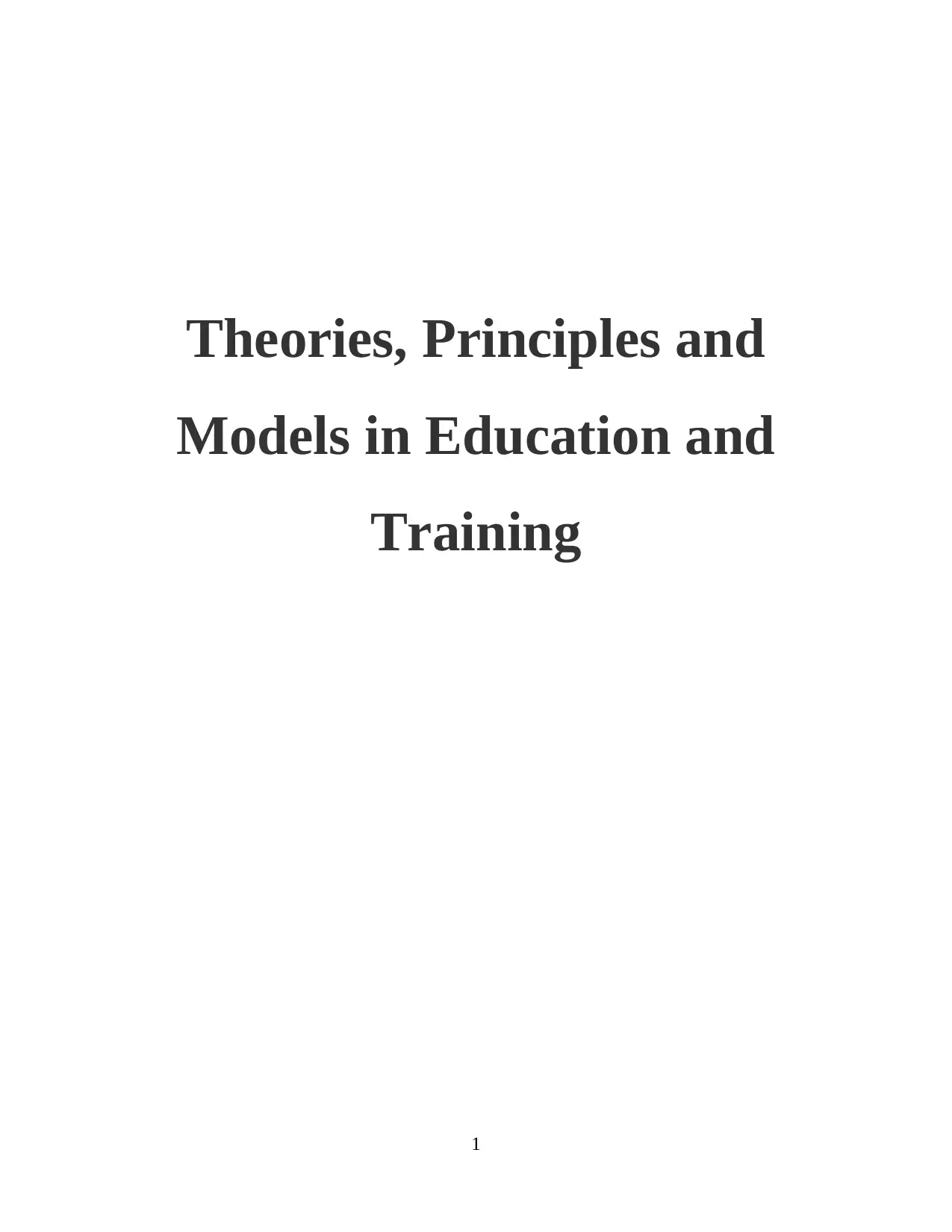
Theories, Principles and
Models in Education and
Training
1
Models in Education and
Training
1
Secure Best Marks with AI Grader
Need help grading? Try our AI Grader for instant feedback on your assignments.
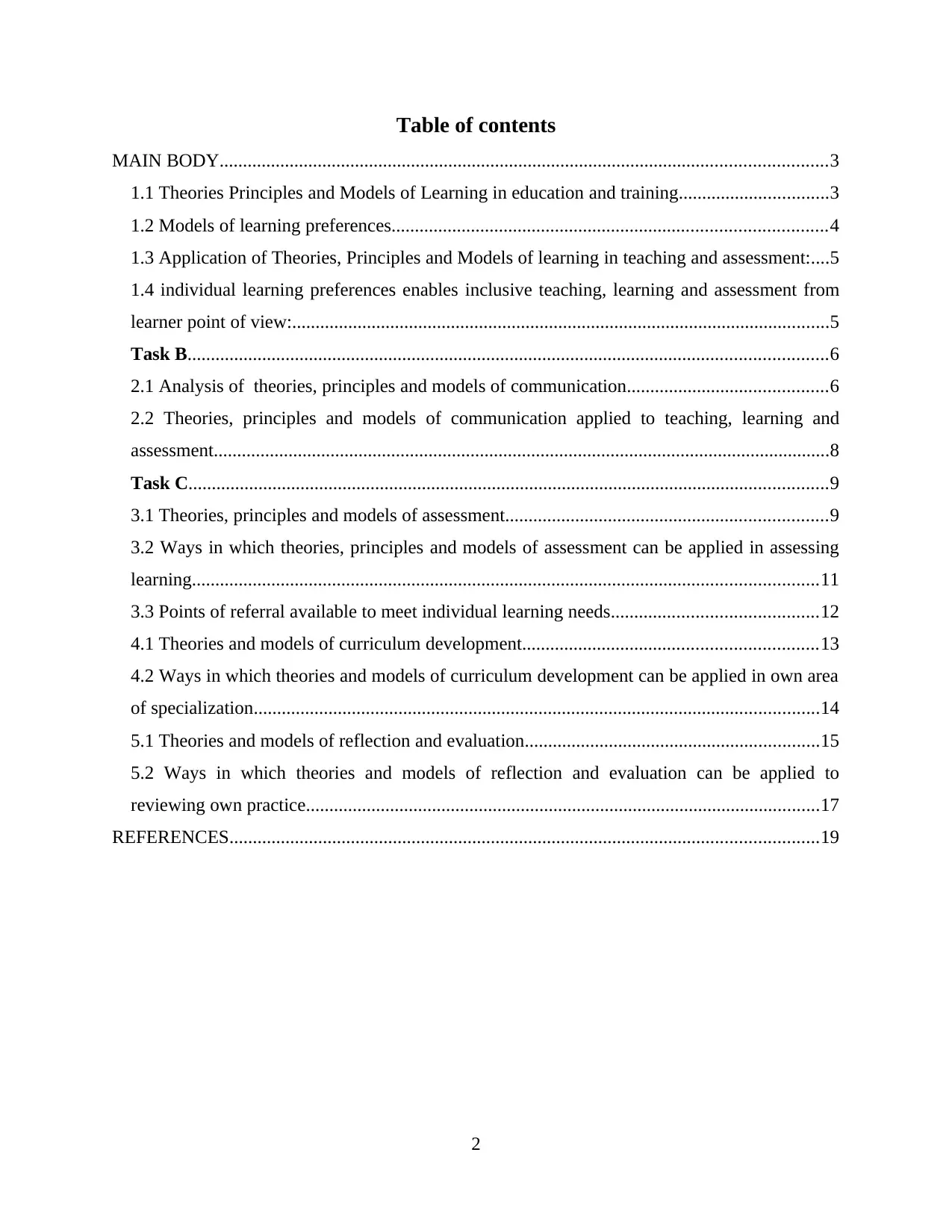
Table of contents
MAIN BODY..................................................................................................................................3
1.1 Theories Principles and Models of Learning in education and training................................3
1.2 Models of learning preferences.............................................................................................4
1.3 Application of Theories, Principles and Models of learning in teaching and assessment:....5
1.4 individual learning preferences enables inclusive teaching, learning and assessment from
learner point of view:...................................................................................................................5
Task B.........................................................................................................................................6
2.1 Analysis of theories, principles and models of communication...........................................6
2.2 Theories, principles and models of communication applied to teaching, learning and
assessment....................................................................................................................................8
Task C.........................................................................................................................................9
3.1 Theories, principles and models of assessment.....................................................................9
3.2 Ways in which theories, principles and models of assessment can be applied in assessing
learning......................................................................................................................................11
3.3 Points of referral available to meet individual learning needs............................................12
4.1 Theories and models of curriculum development...............................................................13
4.2 Ways in which theories and models of curriculum development can be applied in own area
of specialization.........................................................................................................................14
5.1 Theories and models of reflection and evaluation...............................................................15
5.2 Ways in which theories and models of reflection and evaluation can be applied to
reviewing own practice..............................................................................................................17
REFERENCES..............................................................................................................................19
2
MAIN BODY..................................................................................................................................3
1.1 Theories Principles and Models of Learning in education and training................................3
1.2 Models of learning preferences.............................................................................................4
1.3 Application of Theories, Principles and Models of learning in teaching and assessment:....5
1.4 individual learning preferences enables inclusive teaching, learning and assessment from
learner point of view:...................................................................................................................5
Task B.........................................................................................................................................6
2.1 Analysis of theories, principles and models of communication...........................................6
2.2 Theories, principles and models of communication applied to teaching, learning and
assessment....................................................................................................................................8
Task C.........................................................................................................................................9
3.1 Theories, principles and models of assessment.....................................................................9
3.2 Ways in which theories, principles and models of assessment can be applied in assessing
learning......................................................................................................................................11
3.3 Points of referral available to meet individual learning needs............................................12
4.1 Theories and models of curriculum development...............................................................13
4.2 Ways in which theories and models of curriculum development can be applied in own area
of specialization.........................................................................................................................14
5.1 Theories and models of reflection and evaluation...............................................................15
5.2 Ways in which theories and models of reflection and evaluation can be applied to
reviewing own practice..............................................................................................................17
REFERENCES..............................................................................................................................19
2
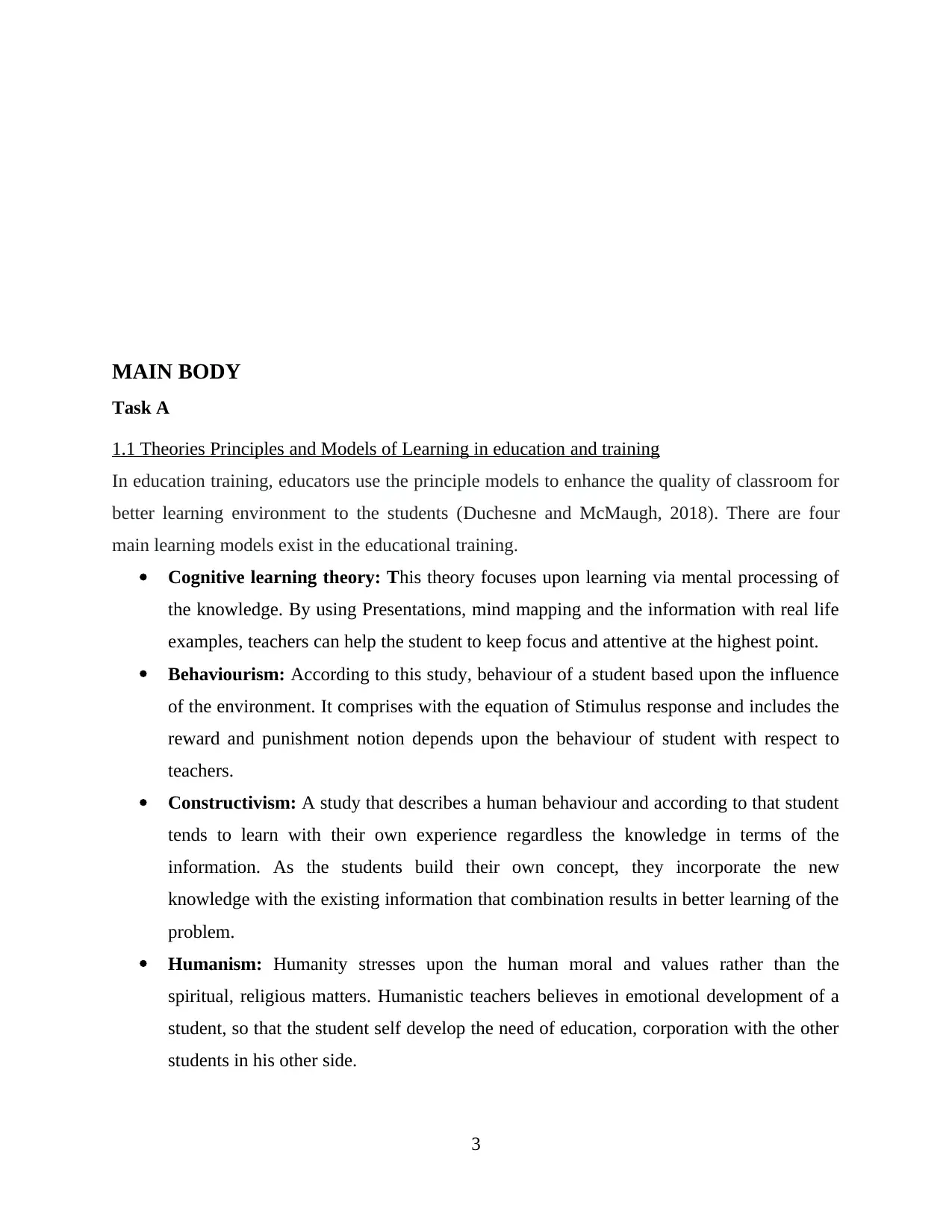
MAIN BODY
Task A
1.1 Theories Principles and Models of Learning in education and training
In education training, educators use the principle models to enhance the quality of classroom for
better learning environment to the students (Duchesne and McMaugh, 2018). There are four
main learning models exist in the educational training.
Cognitive learning theory: This theory focuses upon learning via mental processing of
the knowledge. By using Presentations, mind mapping and the information with real life
examples, teachers can help the student to keep focus and attentive at the highest point.
Behaviourism: According to this study, behaviour of a student based upon the influence
of the environment. It comprises with the equation of Stimulus response and includes the
reward and punishment notion depends upon the behaviour of student with respect to
teachers.
Constructivism: A study that describes a human behaviour and according to that student
tends to learn with their own experience regardless the knowledge in terms of the
information. As the students build their own concept, they incorporate the new
knowledge with the existing information that combination results in better learning of the
problem.
Humanism: Humanity stresses upon the human moral and values rather than the
spiritual, religious matters. Humanistic teachers believes in emotional development of a
student, so that the student self develop the need of education, corporation with the other
students in his other side.
3
Task A
1.1 Theories Principles and Models of Learning in education and training
In education training, educators use the principle models to enhance the quality of classroom for
better learning environment to the students (Duchesne and McMaugh, 2018). There are four
main learning models exist in the educational training.
Cognitive learning theory: This theory focuses upon learning via mental processing of
the knowledge. By using Presentations, mind mapping and the information with real life
examples, teachers can help the student to keep focus and attentive at the highest point.
Behaviourism: According to this study, behaviour of a student based upon the influence
of the environment. It comprises with the equation of Stimulus response and includes the
reward and punishment notion depends upon the behaviour of student with respect to
teachers.
Constructivism: A study that describes a human behaviour and according to that student
tends to learn with their own experience regardless the knowledge in terms of the
information. As the students build their own concept, they incorporate the new
knowledge with the existing information that combination results in better learning of the
problem.
Humanism: Humanity stresses upon the human moral and values rather than the
spiritual, religious matters. Humanistic teachers believes in emotional development of a
student, so that the student self develop the need of education, corporation with the other
students in his other side.
3
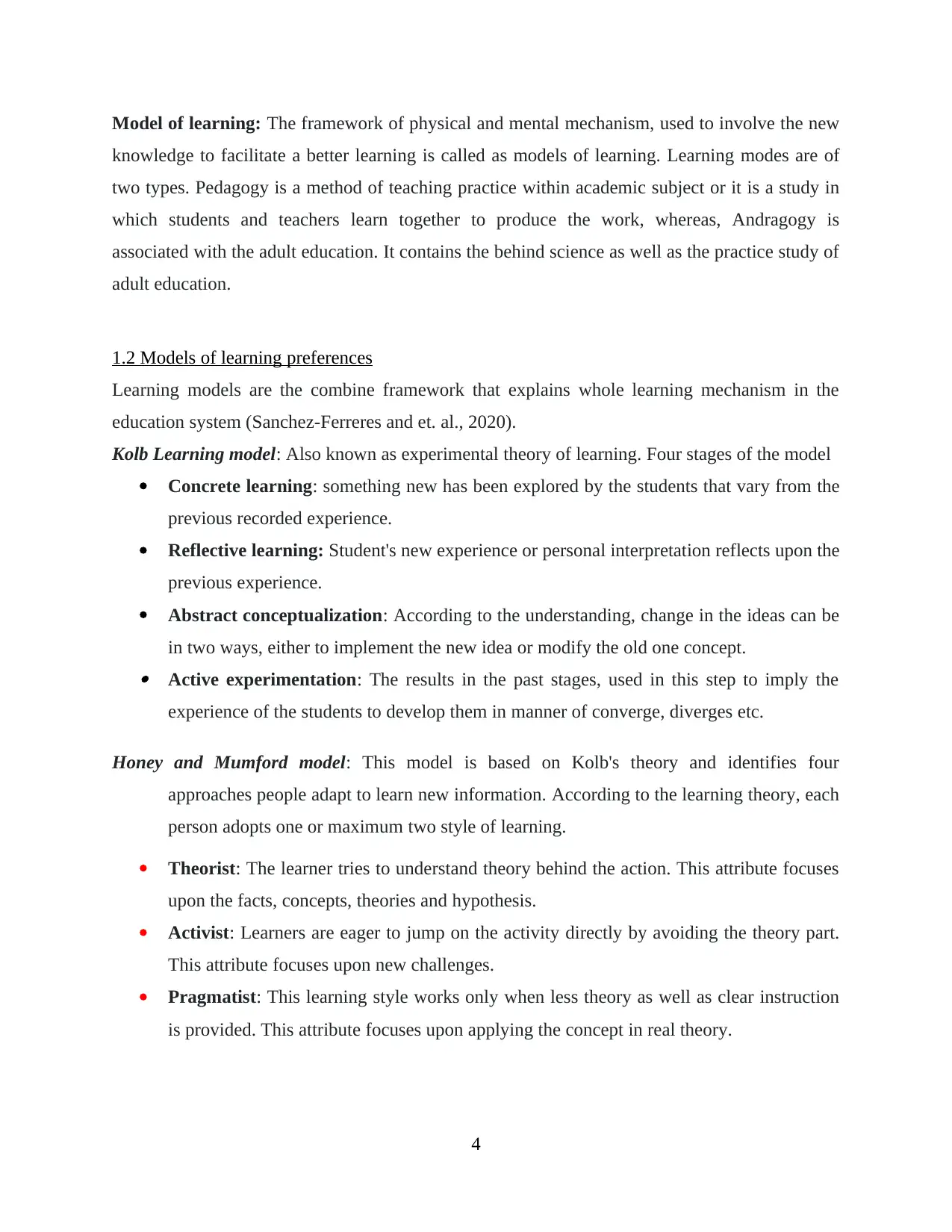
Model of learning: The framework of physical and mental mechanism, used to involve the new
knowledge to facilitate a better learning is called as models of learning. Learning modes are of
two types. Pedagogy is a method of teaching practice within academic subject or it is a study in
which students and teachers learn together to produce the work, whereas, Andragogy is
associated with the adult education. It contains the behind science as well as the practice study of
adult education.
1.2 Models of learning preferences
Learning models are the combine framework that explains whole learning mechanism in the
education system (Sanchez-Ferreres and et. al., 2020).
Kolb Learning model: Also known as experimental theory of learning. Four stages of the model
Concrete learning: something new has been explored by the students that vary from the
previous recorded experience.
Reflective learning: Student's new experience or personal interpretation reflects upon the
previous experience.
Abstract conceptualization: According to the understanding, change in the ideas can be
in two ways, either to implement the new idea or modify the old one concept. Active experimentation: The results in the past stages, used in this step to imply the
experience of the students to develop them in manner of converge, diverges etc.
Honey and Mumford model: This model is based on Kolb's theory and identifies four
approaches people adapt to learn new information. According to the learning theory, each
person adopts one or maximum two style of learning.
Theorist: The learner tries to understand theory behind the action. This attribute focuses
upon the facts, concepts, theories and hypothesis.
Activist: Learners are eager to jump on the activity directly by avoiding the theory part.
This attribute focuses upon new challenges.
Pragmatist: This learning style works only when less theory as well as clear instruction
is provided. This attribute focuses upon applying the concept in real theory.
4
knowledge to facilitate a better learning is called as models of learning. Learning modes are of
two types. Pedagogy is a method of teaching practice within academic subject or it is a study in
which students and teachers learn together to produce the work, whereas, Andragogy is
associated with the adult education. It contains the behind science as well as the practice study of
adult education.
1.2 Models of learning preferences
Learning models are the combine framework that explains whole learning mechanism in the
education system (Sanchez-Ferreres and et. al., 2020).
Kolb Learning model: Also known as experimental theory of learning. Four stages of the model
Concrete learning: something new has been explored by the students that vary from the
previous recorded experience.
Reflective learning: Student's new experience or personal interpretation reflects upon the
previous experience.
Abstract conceptualization: According to the understanding, change in the ideas can be
in two ways, either to implement the new idea or modify the old one concept. Active experimentation: The results in the past stages, used in this step to imply the
experience of the students to develop them in manner of converge, diverges etc.
Honey and Mumford model: This model is based on Kolb's theory and identifies four
approaches people adapt to learn new information. According to the learning theory, each
person adopts one or maximum two style of learning.
Theorist: The learner tries to understand theory behind the action. This attribute focuses
upon the facts, concepts, theories and hypothesis.
Activist: Learners are eager to jump on the activity directly by avoiding the theory part.
This attribute focuses upon new challenges.
Pragmatist: This learning style works only when less theory as well as clear instruction
is provided. This attribute focuses upon applying the concept in real theory.
4
Secure Best Marks with AI Grader
Need help grading? Try our AI Grader for instant feedback on your assignments.
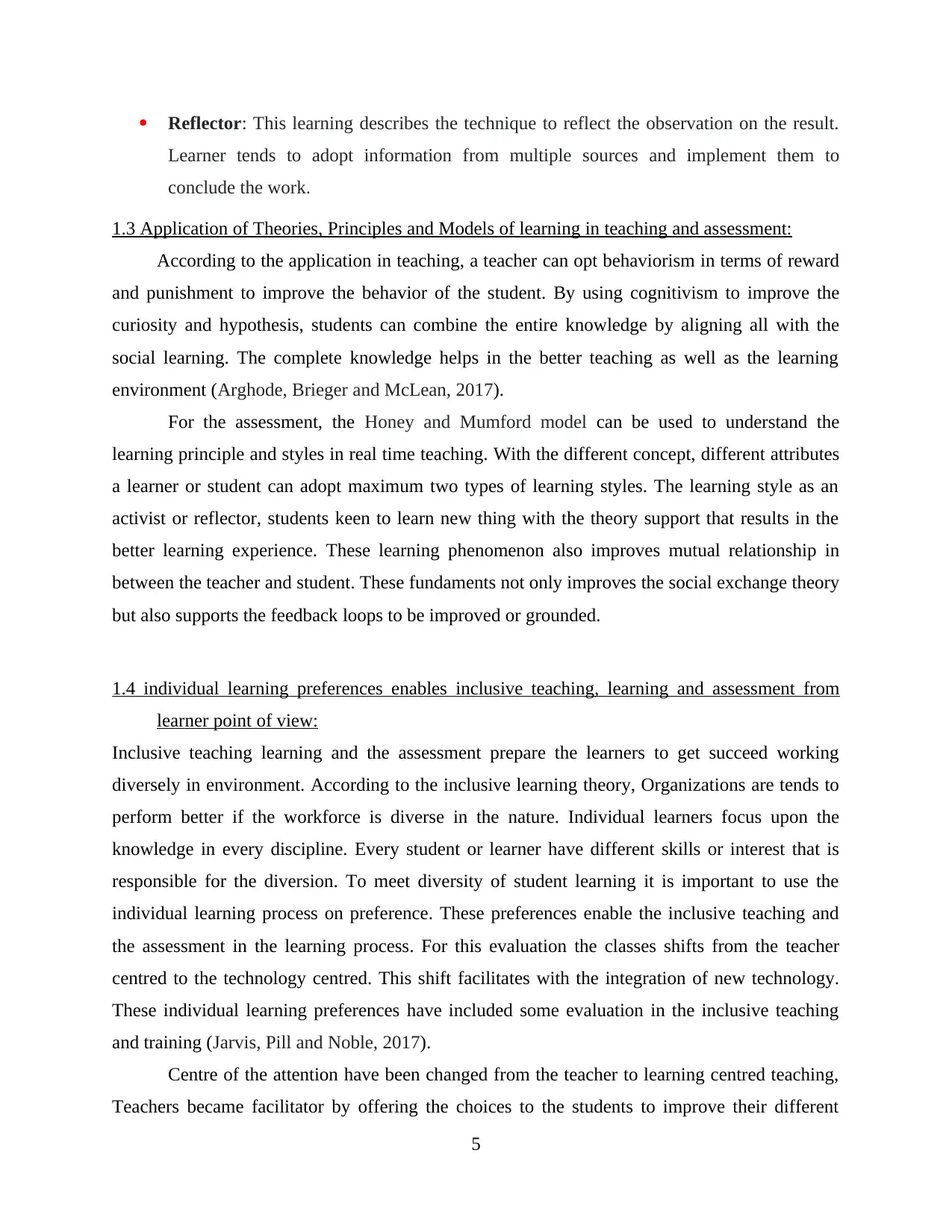
Reflector: This learning describes the technique to reflect the observation on the result.
Learner tends to adopt information from multiple sources and implement them to
conclude the work.
1.3 Application of Theories, Principles and Models of learning in teaching and assessment:
According to the application in teaching, a teacher can opt behaviorism in terms of reward
and punishment to improve the behavior of the student. By using cognitivism to improve the
curiosity and hypothesis, students can combine the entire knowledge by aligning all with the
social learning. The complete knowledge helps in the better teaching as well as the learning
environment (Arghode, Brieger and McLean, 2017).
For the assessment, the Honey and Mumford model can be used to understand the
learning principle and styles in real time teaching. With the different concept, different attributes
a learner or student can adopt maximum two types of learning styles. The learning style as an
activist or reflector, students keen to learn new thing with the theory support that results in the
better learning experience. These learning phenomenon also improves mutual relationship in
between the teacher and student. These fundaments not only improves the social exchange theory
but also supports the feedback loops to be improved or grounded.
1.4 individual learning preferences enables inclusive teaching, learning and assessment from
learner point of view:
Inclusive teaching learning and the assessment prepare the learners to get succeed working
diversely in environment. According to the inclusive learning theory, Organizations are tends to
perform better if the workforce is diverse in the nature. Individual learners focus upon the
knowledge in every discipline. Every student or learner have different skills or interest that is
responsible for the diversion. To meet diversity of student learning it is important to use the
individual learning process on preference. These preferences enable the inclusive teaching and
the assessment in the learning process. For this evaluation the classes shifts from the teacher
centred to the technology centred. This shift facilitates with the integration of new technology.
These individual learning preferences have included some evaluation in the inclusive teaching
and training (Jarvis, Pill and Noble, 2017).
Centre of the attention have been changed from the teacher to learning centred teaching,
Teachers became facilitator by offering the choices to the students to improve their different
5
Learner tends to adopt information from multiple sources and implement them to
conclude the work.
1.3 Application of Theories, Principles and Models of learning in teaching and assessment:
According to the application in teaching, a teacher can opt behaviorism in terms of reward
and punishment to improve the behavior of the student. By using cognitivism to improve the
curiosity and hypothesis, students can combine the entire knowledge by aligning all with the
social learning. The complete knowledge helps in the better teaching as well as the learning
environment (Arghode, Brieger and McLean, 2017).
For the assessment, the Honey and Mumford model can be used to understand the
learning principle and styles in real time teaching. With the different concept, different attributes
a learner or student can adopt maximum two types of learning styles. The learning style as an
activist or reflector, students keen to learn new thing with the theory support that results in the
better learning experience. These learning phenomenon also improves mutual relationship in
between the teacher and student. These fundaments not only improves the social exchange theory
but also supports the feedback loops to be improved or grounded.
1.4 individual learning preferences enables inclusive teaching, learning and assessment from
learner point of view:
Inclusive teaching learning and the assessment prepare the learners to get succeed working
diversely in environment. According to the inclusive learning theory, Organizations are tends to
perform better if the workforce is diverse in the nature. Individual learners focus upon the
knowledge in every discipline. Every student or learner have different skills or interest that is
responsible for the diversion. To meet diversity of student learning it is important to use the
individual learning process on preference. These preferences enable the inclusive teaching and
the assessment in the learning process. For this evaluation the classes shifts from the teacher
centred to the technology centred. This shift facilitates with the integration of new technology.
These individual learning preferences have included some evaluation in the inclusive teaching
and training (Jarvis, Pill and Noble, 2017).
Centre of the attention have been changed from the teacher to learning centred teaching,
Teachers became facilitator by offering the choices to the students to improve their different
5
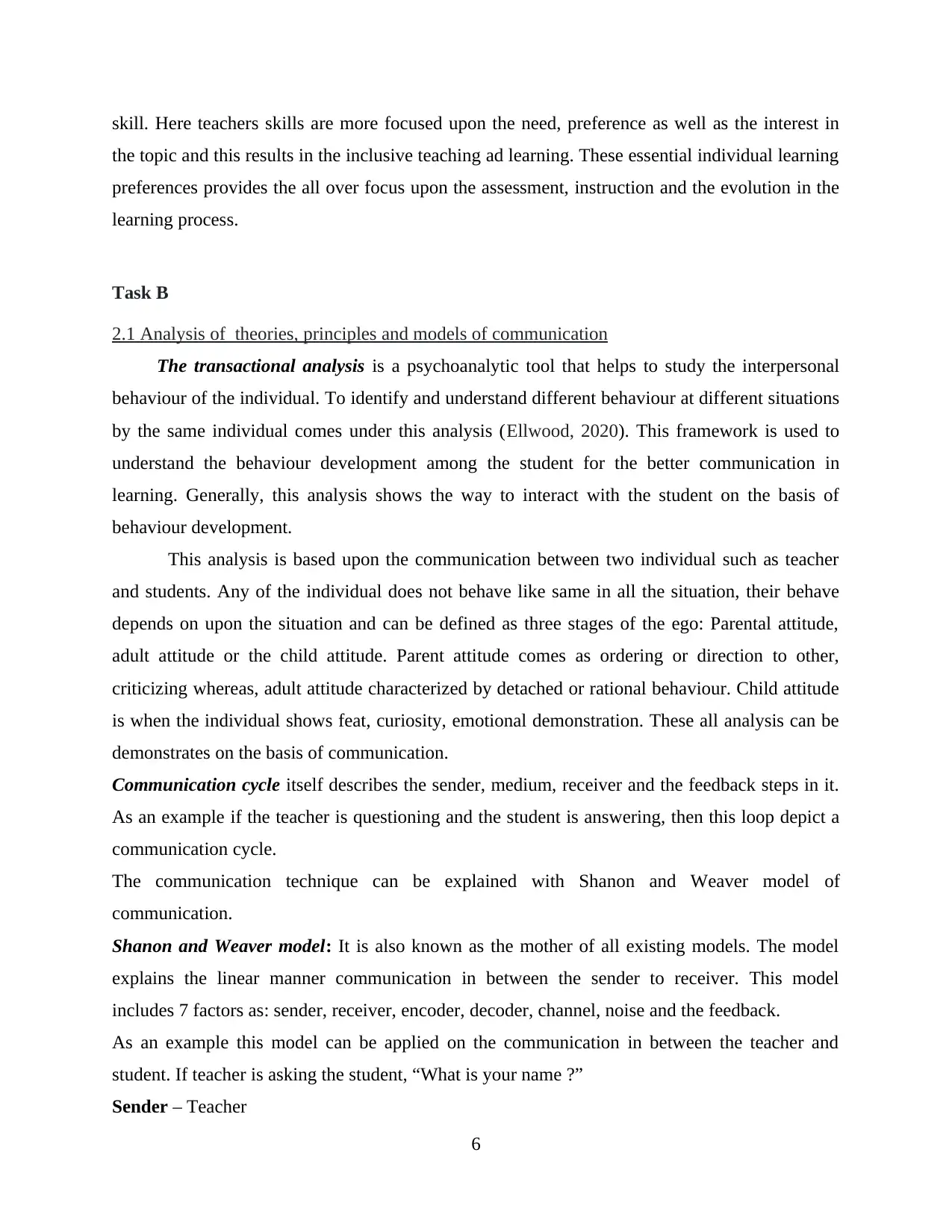
skill. Here teachers skills are more focused upon the need, preference as well as the interest in
the topic and this results in the inclusive teaching ad learning. These essential individual learning
preferences provides the all over focus upon the assessment, instruction and the evolution in the
learning process.
Task B
2.1 Analysis of theories, principles and models of communication
The transactional analysis is a psychoanalytic tool that helps to study the interpersonal
behaviour of the individual. To identify and understand different behaviour at different situations
by the same individual comes under this analysis (Ellwood, 2020). This framework is used to
understand the behaviour development among the student for the better communication in
learning. Generally, this analysis shows the way to interact with the student on the basis of
behaviour development.
This analysis is based upon the communication between two individual such as teacher
and students. Any of the individual does not behave like same in all the situation, their behave
depends on upon the situation and can be defined as three stages of the ego: Parental attitude,
adult attitude or the child attitude. Parent attitude comes as ordering or direction to other,
criticizing whereas, adult attitude characterized by detached or rational behaviour. Child attitude
is when the individual shows feat, curiosity, emotional demonstration. These all analysis can be
demonstrates on the basis of communication.
Communication cycle itself describes the sender, medium, receiver and the feedback steps in it.
As an example if the teacher is questioning and the student is answering, then this loop depict a
communication cycle.
The communication technique can be explained with Shanon and Weaver model of
communication.
Shanon and Weaver model: It is also known as the mother of all existing models. The model
explains the linear manner communication in between the sender to receiver. This model
includes 7 factors as: sender, receiver, encoder, decoder, channel, noise and the feedback.
As an example this model can be applied on the communication in between the teacher and
student. If teacher is asking the student, “What is your name ?”
Sender – Teacher
6
the topic and this results in the inclusive teaching ad learning. These essential individual learning
preferences provides the all over focus upon the assessment, instruction and the evolution in the
learning process.
Task B
2.1 Analysis of theories, principles and models of communication
The transactional analysis is a psychoanalytic tool that helps to study the interpersonal
behaviour of the individual. To identify and understand different behaviour at different situations
by the same individual comes under this analysis (Ellwood, 2020). This framework is used to
understand the behaviour development among the student for the better communication in
learning. Generally, this analysis shows the way to interact with the student on the basis of
behaviour development.
This analysis is based upon the communication between two individual such as teacher
and students. Any of the individual does not behave like same in all the situation, their behave
depends on upon the situation and can be defined as three stages of the ego: Parental attitude,
adult attitude or the child attitude. Parent attitude comes as ordering or direction to other,
criticizing whereas, adult attitude characterized by detached or rational behaviour. Child attitude
is when the individual shows feat, curiosity, emotional demonstration. These all analysis can be
demonstrates on the basis of communication.
Communication cycle itself describes the sender, medium, receiver and the feedback steps in it.
As an example if the teacher is questioning and the student is answering, then this loop depict a
communication cycle.
The communication technique can be explained with Shanon and Weaver model of
communication.
Shanon and Weaver model: It is also known as the mother of all existing models. The model
explains the linear manner communication in between the sender to receiver. This model
includes 7 factors as: sender, receiver, encoder, decoder, channel, noise and the feedback.
As an example this model can be applied on the communication in between the teacher and
student. If teacher is asking the student, “What is your name ?”
Sender – Teacher
6
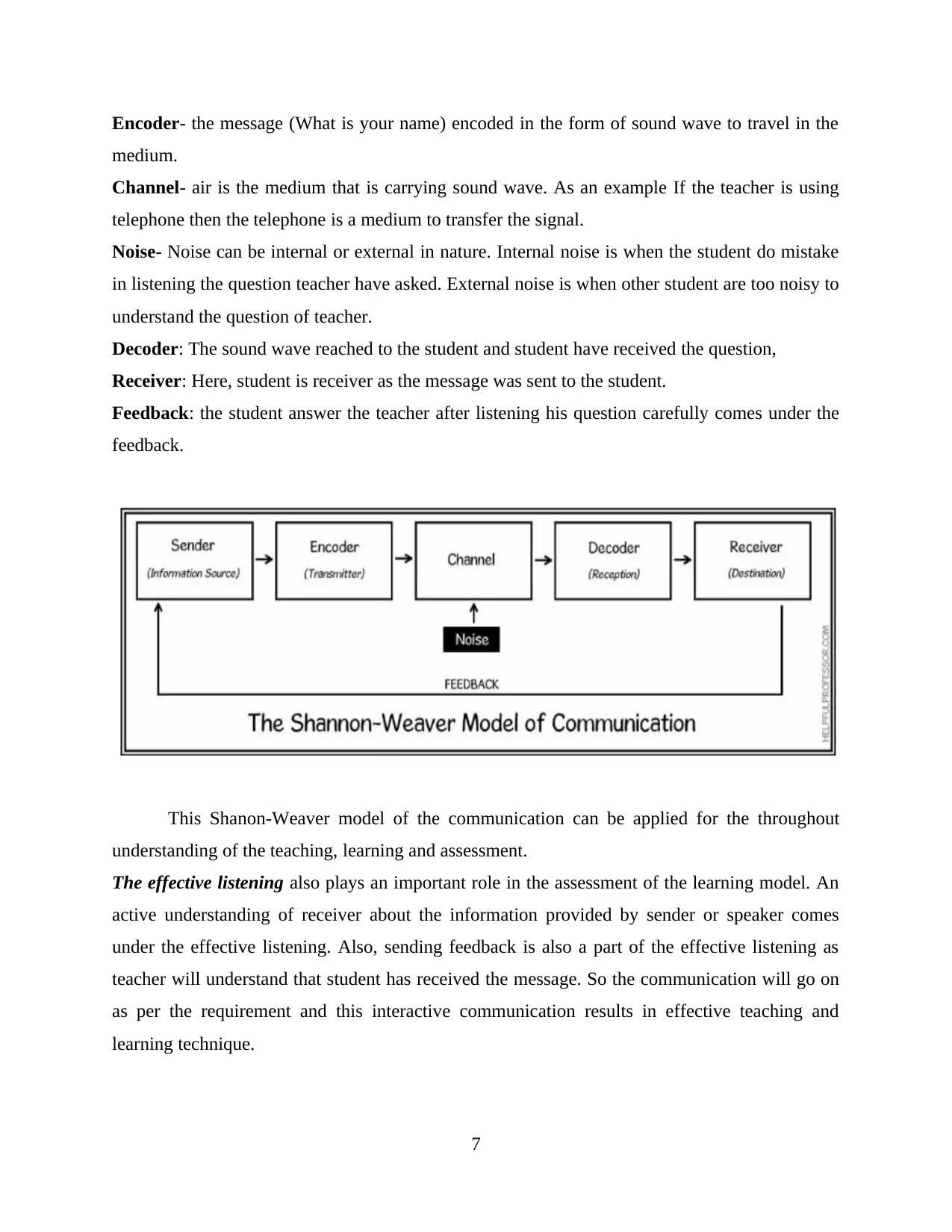
Encoder- the message (What is your name) encoded in the form of sound wave to travel in the
medium.
Channel- air is the medium that is carrying sound wave. As an example If the teacher is using
telephone then the telephone is a medium to transfer the signal.
Noise- Noise can be internal or external in nature. Internal noise is when the student do mistake
in listening the question teacher have asked. External noise is when other student are too noisy to
understand the question of teacher.
Decoder: The sound wave reached to the student and student have received the question,
Receiver: Here, student is receiver as the message was sent to the student.
Feedback: the student answer the teacher after listening his question carefully comes under the
feedback.
This Shanon-Weaver model of the communication can be applied for the throughout
understanding of the teaching, learning and assessment.
The effective listening also plays an important role in the assessment of the learning model. An
active understanding of receiver about the information provided by sender or speaker comes
under the effective listening. Also, sending feedback is also a part of the effective listening as
teacher will understand that student has received the message. So the communication will go on
as per the requirement and this interactive communication results in effective teaching and
learning technique.
7
medium.
Channel- air is the medium that is carrying sound wave. As an example If the teacher is using
telephone then the telephone is a medium to transfer the signal.
Noise- Noise can be internal or external in nature. Internal noise is when the student do mistake
in listening the question teacher have asked. External noise is when other student are too noisy to
understand the question of teacher.
Decoder: The sound wave reached to the student and student have received the question,
Receiver: Here, student is receiver as the message was sent to the student.
Feedback: the student answer the teacher after listening his question carefully comes under the
feedback.
This Shanon-Weaver model of the communication can be applied for the throughout
understanding of the teaching, learning and assessment.
The effective listening also plays an important role in the assessment of the learning model. An
active understanding of receiver about the information provided by sender or speaker comes
under the effective listening. Also, sending feedback is also a part of the effective listening as
teacher will understand that student has received the message. So the communication will go on
as per the requirement and this interactive communication results in effective teaching and
learning technique.
7
Paraphrase This Document
Need a fresh take? Get an instant paraphrase of this document with our AI Paraphraser
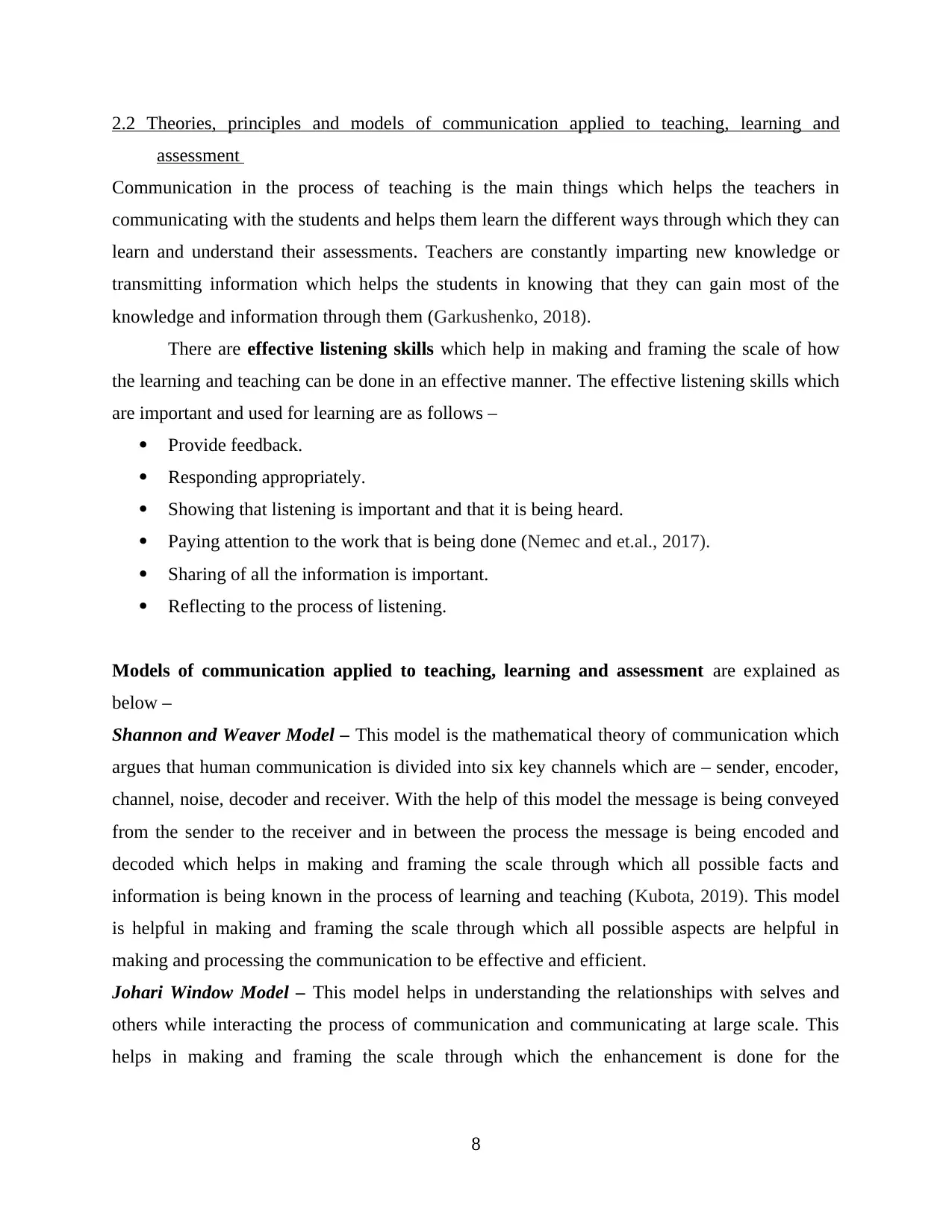
2.2 Theories, principles and models of communication applied to teaching, learning and
assessment
Communication in the process of teaching is the main things which helps the teachers in
communicating with the students and helps them learn the different ways through which they can
learn and understand their assessments. Teachers are constantly imparting new knowledge or
transmitting information which helps the students in knowing that they can gain most of the
knowledge and information through them (Garkushenko, 2018).
There are effective listening skills which help in making and framing the scale of how
the learning and teaching can be done in an effective manner. The effective listening skills which
are important and used for learning are as follows –
Provide feedback.
Responding appropriately.
Showing that listening is important and that it is being heard.
Paying attention to the work that is being done (Nemec and et.al., 2017).
Sharing of all the information is important.
Reflecting to the process of listening.
Models of communication applied to teaching, learning and assessment are explained as
below –
Shannon and Weaver Model – This model is the mathematical theory of communication which
argues that human communication is divided into six key channels which are – sender, encoder,
channel, noise, decoder and receiver. With the help of this model the message is being conveyed
from the sender to the receiver and in between the process the message is being encoded and
decoded which helps in making and framing the scale through which all possible facts and
information is being known in the process of learning and teaching (Kubota, 2019). This model
is helpful in making and framing the scale through which all possible aspects are helpful in
making and processing the communication to be effective and efficient.
Johari Window Model – This model helps in understanding the relationships with selves and
others while interacting the process of communication and communicating at large scale. This
helps in making and framing the scale through which the enhancement is done for the
8
assessment
Communication in the process of teaching is the main things which helps the teachers in
communicating with the students and helps them learn the different ways through which they can
learn and understand their assessments. Teachers are constantly imparting new knowledge or
transmitting information which helps the students in knowing that they can gain most of the
knowledge and information through them (Garkushenko, 2018).
There are effective listening skills which help in making and framing the scale of how
the learning and teaching can be done in an effective manner. The effective listening skills which
are important and used for learning are as follows –
Provide feedback.
Responding appropriately.
Showing that listening is important and that it is being heard.
Paying attention to the work that is being done (Nemec and et.al., 2017).
Sharing of all the information is important.
Reflecting to the process of listening.
Models of communication applied to teaching, learning and assessment are explained as
below –
Shannon and Weaver Model – This model is the mathematical theory of communication which
argues that human communication is divided into six key channels which are – sender, encoder,
channel, noise, decoder and receiver. With the help of this model the message is being conveyed
from the sender to the receiver and in between the process the message is being encoded and
decoded which helps in making and framing the scale through which all possible facts and
information is being known in the process of learning and teaching (Kubota, 2019). This model
is helpful in making and framing the scale through which all possible aspects are helpful in
making and processing the communication to be effective and efficient.
Johari Window Model – This model helps in understanding the relationships with selves and
others while interacting the process of communication and communicating at large scale. This
helps in making and framing the scale through which the enhancement is done for the
8
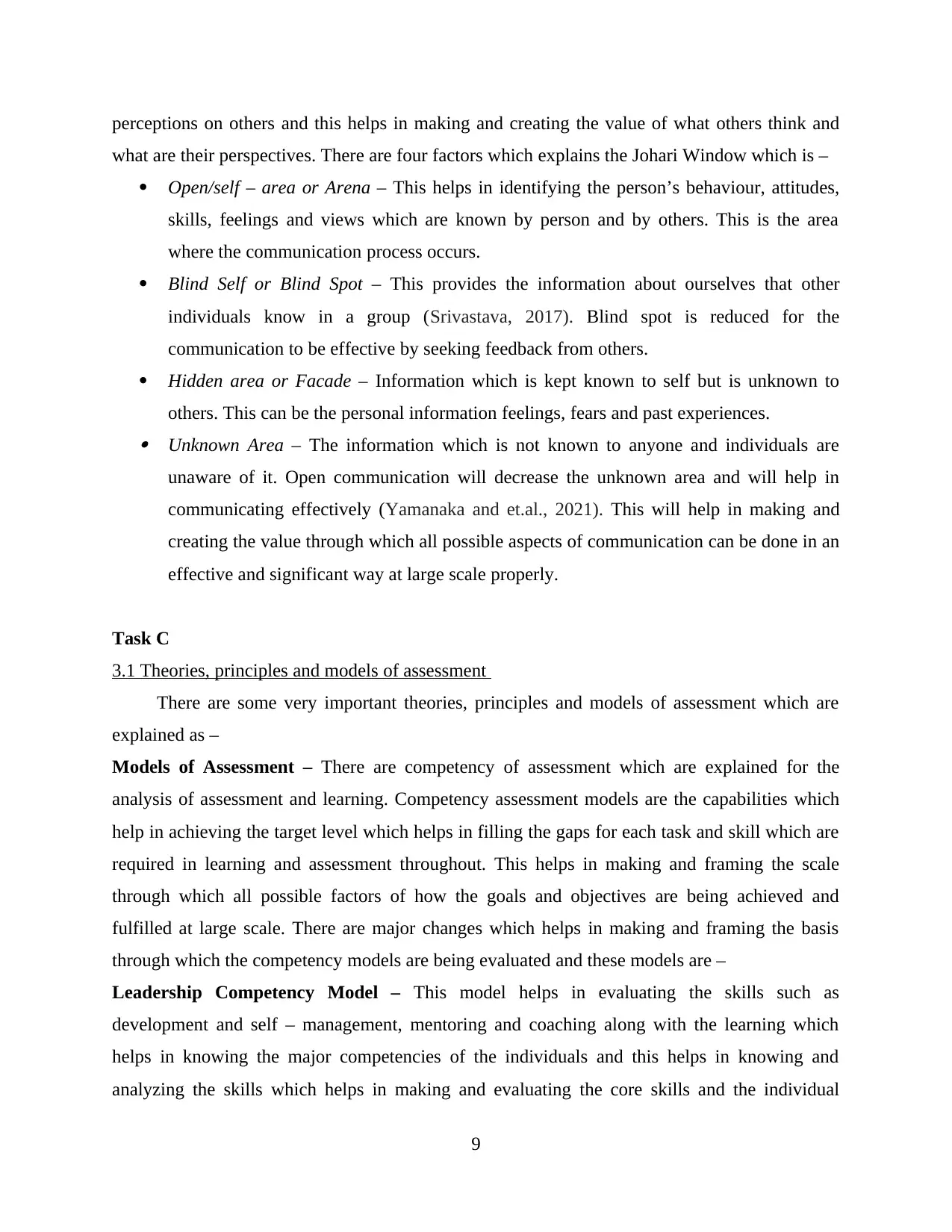
perceptions on others and this helps in making and creating the value of what others think and
what are their perspectives. There are four factors which explains the Johari Window which is –
Open/self – area or Arena – This helps in identifying the person’s behaviour, attitudes,
skills, feelings and views which are known by person and by others. This is the area
where the communication process occurs.
Blind Self or Blind Spot – This provides the information about ourselves that other
individuals know in a group (Srivastava, 2017). Blind spot is reduced for the
communication to be effective by seeking feedback from others.
Hidden area or Facade – Information which is kept known to self but is unknown to
others. This can be the personal information feelings, fears and past experiences. Unknown Area – The information which is not known to anyone and individuals are
unaware of it. Open communication will decrease the unknown area and will help in
communicating effectively (Yamanaka and et.al., 2021). This will help in making and
creating the value through which all possible aspects of communication can be done in an
effective and significant way at large scale properly.
Task C
3.1 Theories, principles and models of assessment
There are some very important theories, principles and models of assessment which are
explained as –
Models of Assessment – There are competency of assessment which are explained for the
analysis of assessment and learning. Competency assessment models are the capabilities which
help in achieving the target level which helps in filling the gaps for each task and skill which are
required in learning and assessment throughout. This helps in making and framing the scale
through which all possible factors of how the goals and objectives are being achieved and
fulfilled at large scale. There are major changes which helps in making and framing the basis
through which the competency models are being evaluated and these models are –
Leadership Competency Model – This model helps in evaluating the skills such as
development and self – management, mentoring and coaching along with the learning which
helps in knowing the major competencies of the individuals and this helps in knowing and
analyzing the skills which helps in making and evaluating the core skills and the individual
9
what are their perspectives. There are four factors which explains the Johari Window which is –
Open/self – area or Arena – This helps in identifying the person’s behaviour, attitudes,
skills, feelings and views which are known by person and by others. This is the area
where the communication process occurs.
Blind Self or Blind Spot – This provides the information about ourselves that other
individuals know in a group (Srivastava, 2017). Blind spot is reduced for the
communication to be effective by seeking feedback from others.
Hidden area or Facade – Information which is kept known to self but is unknown to
others. This can be the personal information feelings, fears and past experiences. Unknown Area – The information which is not known to anyone and individuals are
unaware of it. Open communication will decrease the unknown area and will help in
communicating effectively (Yamanaka and et.al., 2021). This will help in making and
creating the value through which all possible aspects of communication can be done in an
effective and significant way at large scale properly.
Task C
3.1 Theories, principles and models of assessment
There are some very important theories, principles and models of assessment which are
explained as –
Models of Assessment – There are competency of assessment which are explained for the
analysis of assessment and learning. Competency assessment models are the capabilities which
help in achieving the target level which helps in filling the gaps for each task and skill which are
required in learning and assessment throughout. This helps in making and framing the scale
through which all possible factors of how the goals and objectives are being achieved and
fulfilled at large scale. There are major changes which helps in making and framing the basis
through which the competency models are being evaluated and these models are –
Leadership Competency Model – This model helps in evaluating the skills such as
development and self – management, mentoring and coaching along with the learning which
helps in knowing the major competencies of the individuals and this helps in knowing and
analyzing the skills which helps in making and evaluating the core skills and the individual
9
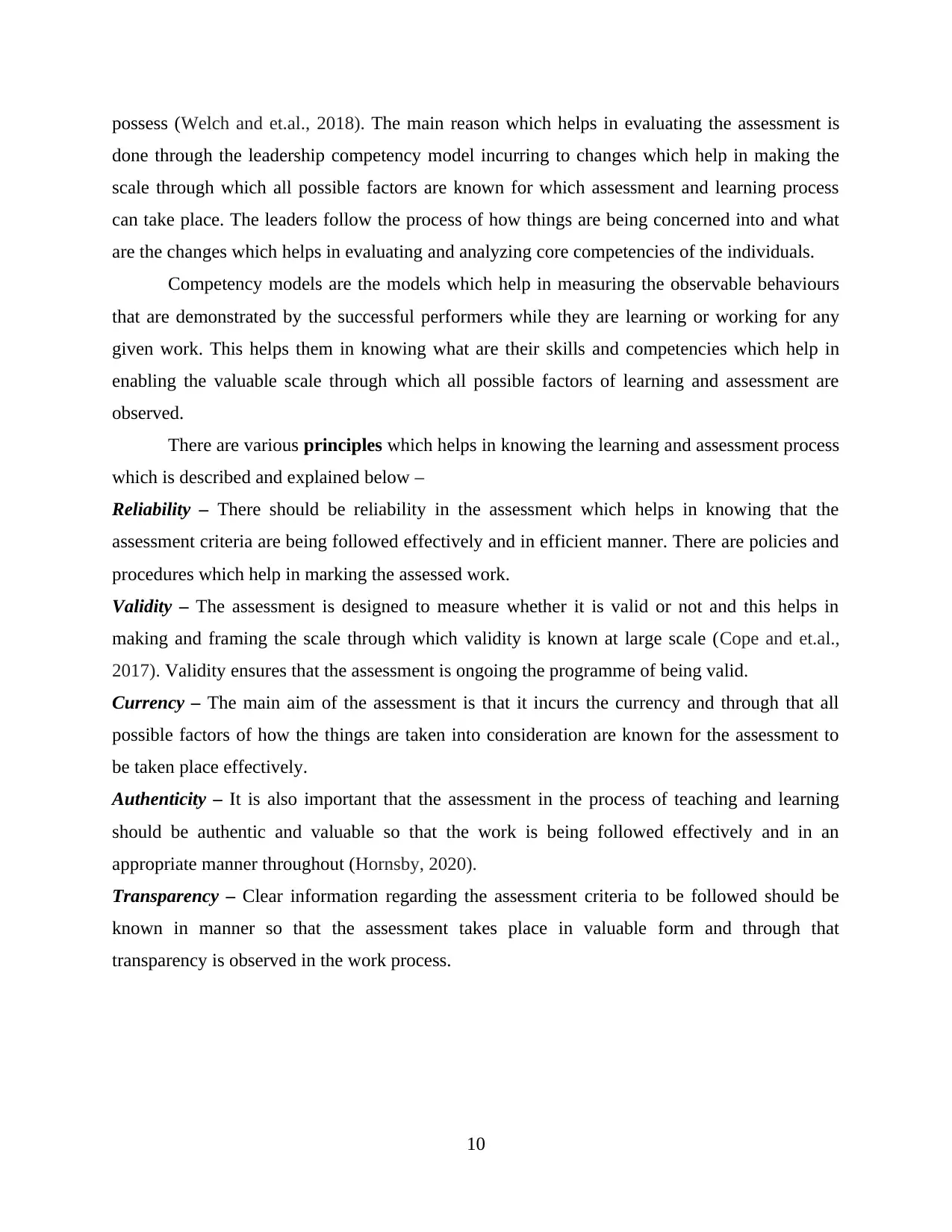
possess (Welch and et.al., 2018). The main reason which helps in evaluating the assessment is
done through the leadership competency model incurring to changes which help in making the
scale through which all possible factors are known for which assessment and learning process
can take place. The leaders follow the process of how things are being concerned into and what
are the changes which helps in evaluating and analyzing core competencies of the individuals.
Competency models are the models which help in measuring the observable behaviours
that are demonstrated by the successful performers while they are learning or working for any
given work. This helps them in knowing what are their skills and competencies which help in
enabling the valuable scale through which all possible factors of learning and assessment are
observed.
There are various principles which helps in knowing the learning and assessment process
which is described and explained below –
Reliability – There should be reliability in the assessment which helps in knowing that the
assessment criteria are being followed effectively and in efficient manner. There are policies and
procedures which help in marking the assessed work.
Validity – The assessment is designed to measure whether it is valid or not and this helps in
making and framing the scale through which validity is known at large scale (Cope and et.al.,
2017). Validity ensures that the assessment is ongoing the programme of being valid.
Currency – The main aim of the assessment is that it incurs the currency and through that all
possible factors of how the things are taken into consideration are known for the assessment to
be taken place effectively.
Authenticity – It is also important that the assessment in the process of teaching and learning
should be authentic and valuable so that the work is being followed effectively and in an
appropriate manner throughout (Hornsby, 2020).
Transparency – Clear information regarding the assessment criteria to be followed should be
known in manner so that the assessment takes place in valuable form and through that
transparency is observed in the work process.
10
done through the leadership competency model incurring to changes which help in making the
scale through which all possible factors are known for which assessment and learning process
can take place. The leaders follow the process of how things are being concerned into and what
are the changes which helps in evaluating and analyzing core competencies of the individuals.
Competency models are the models which help in measuring the observable behaviours
that are demonstrated by the successful performers while they are learning or working for any
given work. This helps them in knowing what are their skills and competencies which help in
enabling the valuable scale through which all possible factors of learning and assessment are
observed.
There are various principles which helps in knowing the learning and assessment process
which is described and explained below –
Reliability – There should be reliability in the assessment which helps in knowing that the
assessment criteria are being followed effectively and in efficient manner. There are policies and
procedures which help in marking the assessed work.
Validity – The assessment is designed to measure whether it is valid or not and this helps in
making and framing the scale through which validity is known at large scale (Cope and et.al.,
2017). Validity ensures that the assessment is ongoing the programme of being valid.
Currency – The main aim of the assessment is that it incurs the currency and through that all
possible factors of how the things are taken into consideration are known for the assessment to
be taken place effectively.
Authenticity – It is also important that the assessment in the process of teaching and learning
should be authentic and valuable so that the work is being followed effectively and in an
appropriate manner throughout (Hornsby, 2020).
Transparency – Clear information regarding the assessment criteria to be followed should be
known in manner so that the assessment takes place in valuable form and through that
transparency is observed in the work process.
10
Secure Best Marks with AI Grader
Need help grading? Try our AI Grader for instant feedback on your assignments.
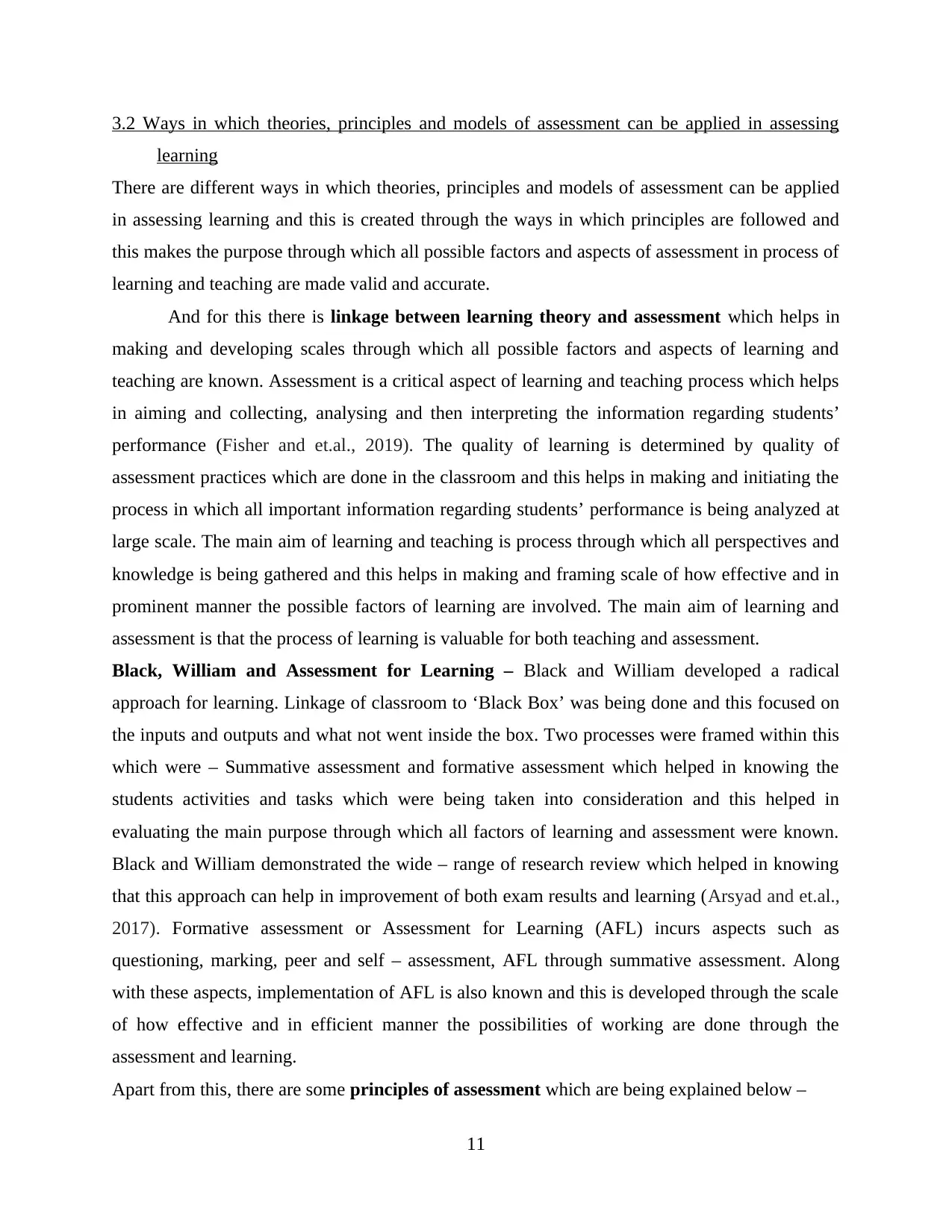
3.2 Ways in which theories, principles and models of assessment can be applied in assessing
learning
There are different ways in which theories, principles and models of assessment can be applied
in assessing learning and this is created through the ways in which principles are followed and
this makes the purpose through which all possible factors and aspects of assessment in process of
learning and teaching are made valid and accurate.
And for this there is linkage between learning theory and assessment which helps in
making and developing scales through which all possible factors and aspects of learning and
teaching are known. Assessment is a critical aspect of learning and teaching process which helps
in aiming and collecting, analysing and then interpreting the information regarding students’
performance (Fisher and et.al., 2019). The quality of learning is determined by quality of
assessment practices which are done in the classroom and this helps in making and initiating the
process in which all important information regarding students’ performance is being analyzed at
large scale. The main aim of learning and teaching is process through which all perspectives and
knowledge is being gathered and this helps in making and framing scale of how effective and in
prominent manner the possible factors of learning are involved. The main aim of learning and
assessment is that the process of learning is valuable for both teaching and assessment.
Black, William and Assessment for Learning – Black and William developed a radical
approach for learning. Linkage of classroom to ‘Black Box’ was being done and this focused on
the inputs and outputs and what not went inside the box. Two processes were framed within this
which were – Summative assessment and formative assessment which helped in knowing the
students activities and tasks which were being taken into consideration and this helped in
evaluating the main purpose through which all factors of learning and assessment were known.
Black and William demonstrated the wide – range of research review which helped in knowing
that this approach can help in improvement of both exam results and learning (Arsyad and et.al.,
2017). Formative assessment or Assessment for Learning (AFL) incurs aspects such as
questioning, marking, peer and self – assessment, AFL through summative assessment. Along
with these aspects, implementation of AFL is also known and this is developed through the scale
of how effective and in efficient manner the possibilities of working are done through the
assessment and learning.
Apart from this, there are some principles of assessment which are being explained below –
11
learning
There are different ways in which theories, principles and models of assessment can be applied
in assessing learning and this is created through the ways in which principles are followed and
this makes the purpose through which all possible factors and aspects of assessment in process of
learning and teaching are made valid and accurate.
And for this there is linkage between learning theory and assessment which helps in
making and developing scales through which all possible factors and aspects of learning and
teaching are known. Assessment is a critical aspect of learning and teaching process which helps
in aiming and collecting, analysing and then interpreting the information regarding students’
performance (Fisher and et.al., 2019). The quality of learning is determined by quality of
assessment practices which are done in the classroom and this helps in making and initiating the
process in which all important information regarding students’ performance is being analyzed at
large scale. The main aim of learning and teaching is process through which all perspectives and
knowledge is being gathered and this helps in making and framing scale of how effective and in
prominent manner the possible factors of learning are involved. The main aim of learning and
assessment is that the process of learning is valuable for both teaching and assessment.
Black, William and Assessment for Learning – Black and William developed a radical
approach for learning. Linkage of classroom to ‘Black Box’ was being done and this focused on
the inputs and outputs and what not went inside the box. Two processes were framed within this
which were – Summative assessment and formative assessment which helped in knowing the
students activities and tasks which were being taken into consideration and this helped in
evaluating the main purpose through which all factors of learning and assessment were known.
Black and William demonstrated the wide – range of research review which helped in knowing
that this approach can help in improvement of both exam results and learning (Arsyad and et.al.,
2017). Formative assessment or Assessment for Learning (AFL) incurs aspects such as
questioning, marking, peer and self – assessment, AFL through summative assessment. Along
with these aspects, implementation of AFL is also known and this is developed through the scale
of how effective and in efficient manner the possibilities of working are done through the
assessment and learning.
Apart from this, there are some principles of assessment which are being explained below –
11
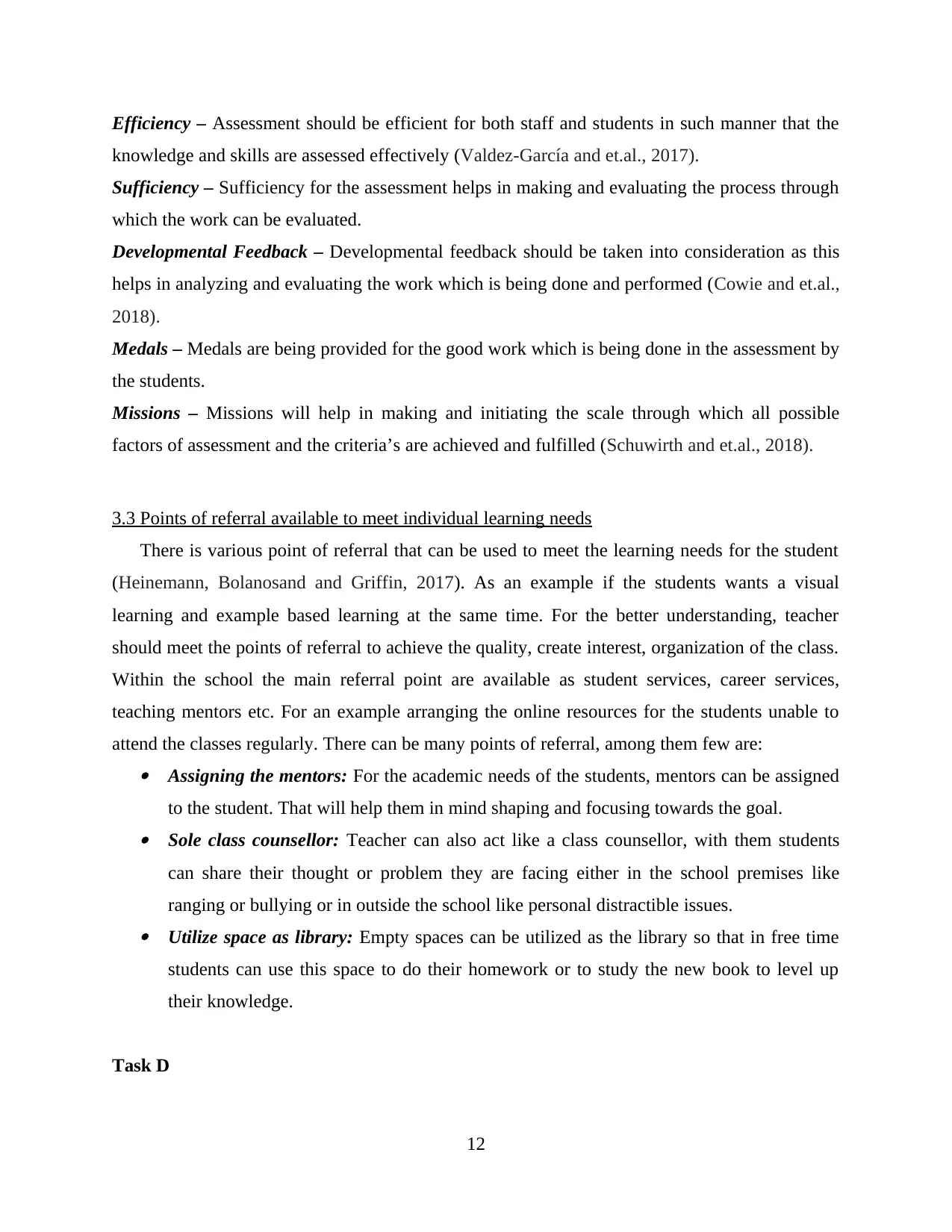
Efficiency – Assessment should be efficient for both staff and students in such manner that the
knowledge and skills are assessed effectively (Valdez-García and et.al., 2017).
Sufficiency – Sufficiency for the assessment helps in making and evaluating the process through
which the work can be evaluated.
Developmental Feedback – Developmental feedback should be taken into consideration as this
helps in analyzing and evaluating the work which is being done and performed (Cowie and et.al.,
2018).
Medals – Medals are being provided for the good work which is being done in the assessment by
the students.
Missions – Missions will help in making and initiating the scale through which all possible
factors of assessment and the criteria’s are achieved and fulfilled (Schuwirth and et.al., 2018).
3.3 Points of referral available to meet individual learning needs
There is various point of referral that can be used to meet the learning needs for the student
(Heinemann, Bolanosand and Griffin, 2017). As an example if the students wants a visual
learning and example based learning at the same time. For the better understanding, teacher
should meet the points of referral to achieve the quality, create interest, organization of the class.
Within the school the main referral point are available as student services, career services,
teaching mentors etc. For an example arranging the online resources for the students unable to
attend the classes regularly. There can be many points of referral, among them few are: Assigning the mentors: For the academic needs of the students, mentors can be assigned
to the student. That will help them in mind shaping and focusing towards the goal. Sole class counsellor: Teacher can also act like a class counsellor, with them students
can share their thought or problem they are facing either in the school premises like
ranging or bullying or in outside the school like personal distractible issues. Utilize space as library: Empty spaces can be utilized as the library so that in free time
students can use this space to do their homework or to study the new book to level up
their knowledge.
Task D
12
knowledge and skills are assessed effectively (Valdez-García and et.al., 2017).
Sufficiency – Sufficiency for the assessment helps in making and evaluating the process through
which the work can be evaluated.
Developmental Feedback – Developmental feedback should be taken into consideration as this
helps in analyzing and evaluating the work which is being done and performed (Cowie and et.al.,
2018).
Medals – Medals are being provided for the good work which is being done in the assessment by
the students.
Missions – Missions will help in making and initiating the scale through which all possible
factors of assessment and the criteria’s are achieved and fulfilled (Schuwirth and et.al., 2018).
3.3 Points of referral available to meet individual learning needs
There is various point of referral that can be used to meet the learning needs for the student
(Heinemann, Bolanosand and Griffin, 2017). As an example if the students wants a visual
learning and example based learning at the same time. For the better understanding, teacher
should meet the points of referral to achieve the quality, create interest, organization of the class.
Within the school the main referral point are available as student services, career services,
teaching mentors etc. For an example arranging the online resources for the students unable to
attend the classes regularly. There can be many points of referral, among them few are: Assigning the mentors: For the academic needs of the students, mentors can be assigned
to the student. That will help them in mind shaping and focusing towards the goal. Sole class counsellor: Teacher can also act like a class counsellor, with them students
can share their thought or problem they are facing either in the school premises like
ranging or bullying or in outside the school like personal distractible issues. Utilize space as library: Empty spaces can be utilized as the library so that in free time
students can use this space to do their homework or to study the new book to level up
their knowledge.
Task D
12
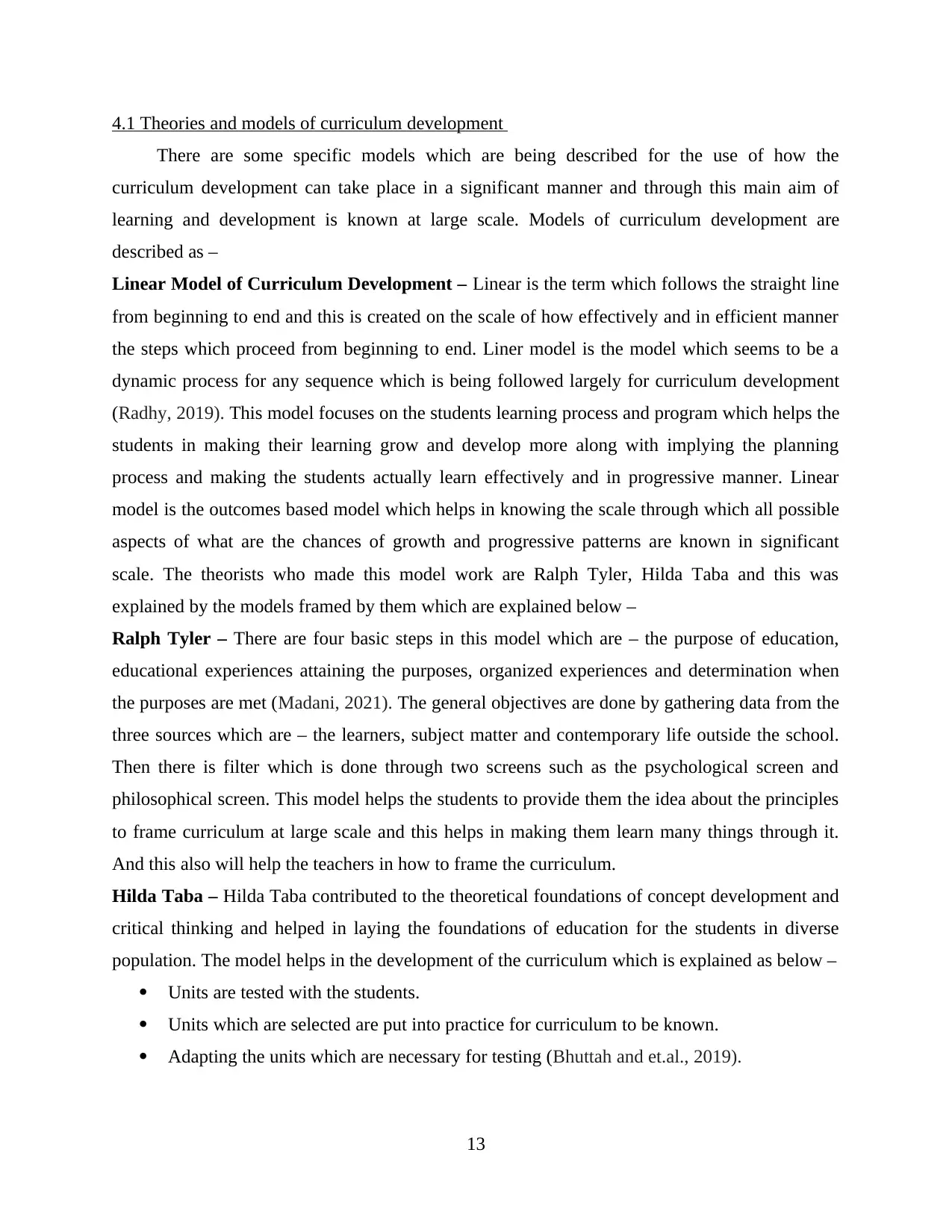
4.1 Theories and models of curriculum development
There are some specific models which are being described for the use of how the
curriculum development can take place in a significant manner and through this main aim of
learning and development is known at large scale. Models of curriculum development are
described as –
Linear Model of Curriculum Development – Linear is the term which follows the straight line
from beginning to end and this is created on the scale of how effectively and in efficient manner
the steps which proceed from beginning to end. Liner model is the model which seems to be a
dynamic process for any sequence which is being followed largely for curriculum development
(Radhy, 2019). This model focuses on the students learning process and program which helps the
students in making their learning grow and develop more along with implying the planning
process and making the students actually learn effectively and in progressive manner. Linear
model is the outcomes based model which helps in knowing the scale through which all possible
aspects of what are the chances of growth and progressive patterns are known in significant
scale. The theorists who made this model work are Ralph Tyler, Hilda Taba and this was
explained by the models framed by them which are explained below –
Ralph Tyler – There are four basic steps in this model which are – the purpose of education,
educational experiences attaining the purposes, organized experiences and determination when
the purposes are met (Madani, 2021). The general objectives are done by gathering data from the
three sources which are – the learners, subject matter and contemporary life outside the school.
Then there is filter which is done through two screens such as the psychological screen and
philosophical screen. This model helps the students to provide them the idea about the principles
to frame curriculum at large scale and this helps in making them learn many things through it.
And this also will help the teachers in how to frame the curriculum.
Hilda Taba – Hilda Taba contributed to the theoretical foundations of concept development and
critical thinking and helped in laying the foundations of education for the students in diverse
population. The model helps in the development of the curriculum which is explained as below –
Units are tested with the students.
Units which are selected are put into practice for curriculum to be known.
Adapting the units which are necessary for testing (Bhuttah and et.al., 2019).
13
There are some specific models which are being described for the use of how the
curriculum development can take place in a significant manner and through this main aim of
learning and development is known at large scale. Models of curriculum development are
described as –
Linear Model of Curriculum Development – Linear is the term which follows the straight line
from beginning to end and this is created on the scale of how effectively and in efficient manner
the steps which proceed from beginning to end. Liner model is the model which seems to be a
dynamic process for any sequence which is being followed largely for curriculum development
(Radhy, 2019). This model focuses on the students learning process and program which helps the
students in making their learning grow and develop more along with implying the planning
process and making the students actually learn effectively and in progressive manner. Linear
model is the outcomes based model which helps in knowing the scale through which all possible
aspects of what are the chances of growth and progressive patterns are known in significant
scale. The theorists who made this model work are Ralph Tyler, Hilda Taba and this was
explained by the models framed by them which are explained below –
Ralph Tyler – There are four basic steps in this model which are – the purpose of education,
educational experiences attaining the purposes, organized experiences and determination when
the purposes are met (Madani, 2021). The general objectives are done by gathering data from the
three sources which are – the learners, subject matter and contemporary life outside the school.
Then there is filter which is done through two screens such as the psychological screen and
philosophical screen. This model helps the students to provide them the idea about the principles
to frame curriculum at large scale and this helps in making them learn many things through it.
And this also will help the teachers in how to frame the curriculum.
Hilda Taba – Hilda Taba contributed to the theoretical foundations of concept development and
critical thinking and helped in laying the foundations of education for the students in diverse
population. The model helps in the development of the curriculum which is explained as below –
Units are tested with the students.
Units which are selected are put into practice for curriculum to be known.
Adapting the units which are necessary for testing (Bhuttah and et.al., 2019).
13
Paraphrase This Document
Need a fresh take? Get an instant paraphrase of this document with our AI Paraphraser
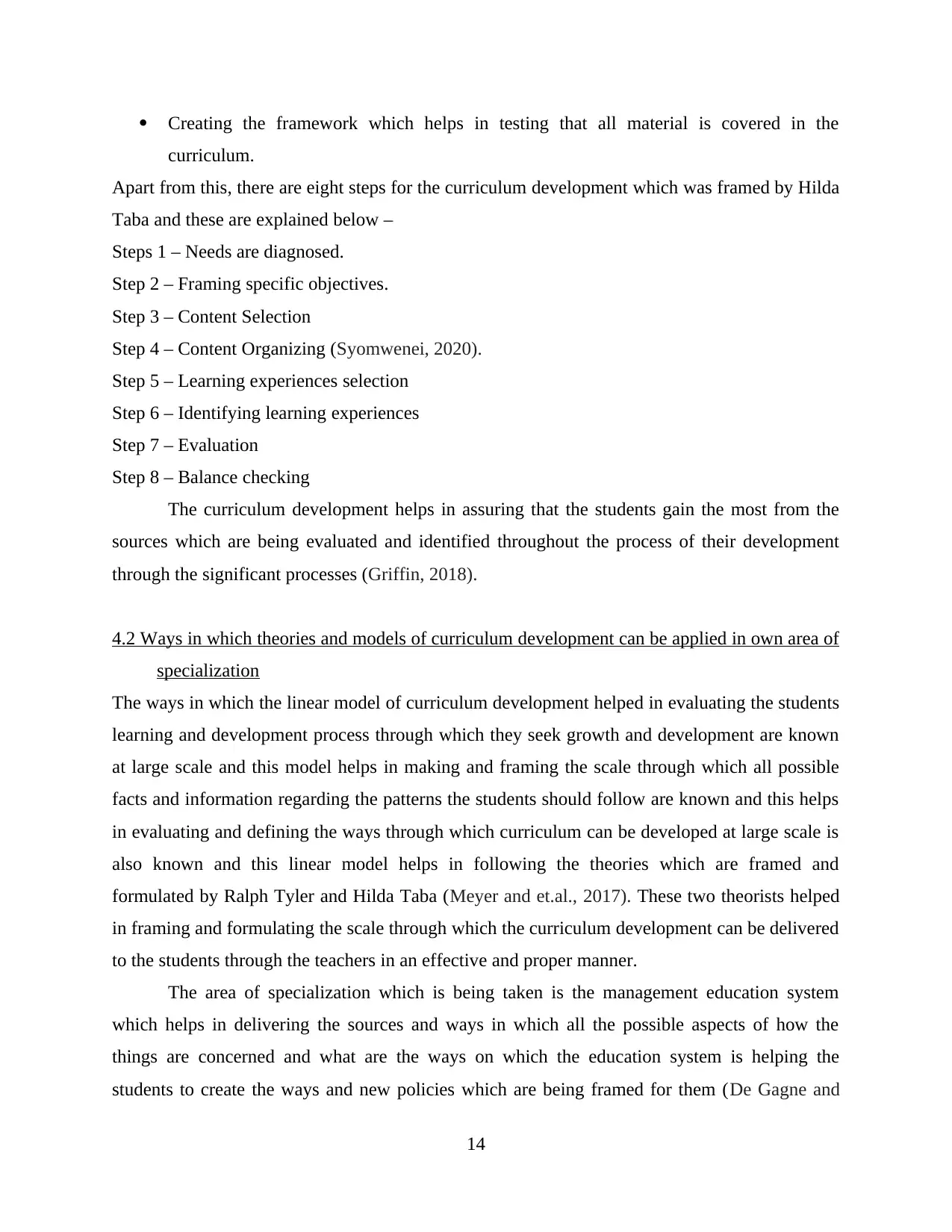
Creating the framework which helps in testing that all material is covered in the
curriculum.
Apart from this, there are eight steps for the curriculum development which was framed by Hilda
Taba and these are explained below –
Steps 1 – Needs are diagnosed.
Step 2 – Framing specific objectives.
Step 3 – Content Selection
Step 4 – Content Organizing (Syomwenei, 2020).
Step 5 – Learning experiences selection
Step 6 – Identifying learning experiences
Step 7 – Evaluation
Step 8 – Balance checking
The curriculum development helps in assuring that the students gain the most from the
sources which are being evaluated and identified throughout the process of their development
through the significant processes (Griffin, 2018).
4.2 Ways in which theories and models of curriculum development can be applied in own area of
specialization
The ways in which the linear model of curriculum development helped in evaluating the students
learning and development process through which they seek growth and development are known
at large scale and this model helps in making and framing the scale through which all possible
facts and information regarding the patterns the students should follow are known and this helps
in evaluating and defining the ways through which curriculum can be developed at large scale is
also known and this linear model helps in following the theories which are framed and
formulated by Ralph Tyler and Hilda Taba (Meyer and et.al., 2017). These two theorists helped
in framing and formulating the scale through which the curriculum development can be delivered
to the students through the teachers in an effective and proper manner.
The area of specialization which is being taken is the management education system
which helps in delivering the sources and ways in which all the possible aspects of how the
things are concerned and what are the ways on which the education system is helping the
students to create the ways and new policies which are being framed for them (De Gagne and
14
curriculum.
Apart from this, there are eight steps for the curriculum development which was framed by Hilda
Taba and these are explained below –
Steps 1 – Needs are diagnosed.
Step 2 – Framing specific objectives.
Step 3 – Content Selection
Step 4 – Content Organizing (Syomwenei, 2020).
Step 5 – Learning experiences selection
Step 6 – Identifying learning experiences
Step 7 – Evaluation
Step 8 – Balance checking
The curriculum development helps in assuring that the students gain the most from the
sources which are being evaluated and identified throughout the process of their development
through the significant processes (Griffin, 2018).
4.2 Ways in which theories and models of curriculum development can be applied in own area of
specialization
The ways in which the linear model of curriculum development helped in evaluating the students
learning and development process through which they seek growth and development are known
at large scale and this model helps in making and framing the scale through which all possible
facts and information regarding the patterns the students should follow are known and this helps
in evaluating and defining the ways through which curriculum can be developed at large scale is
also known and this linear model helps in following the theories which are framed and
formulated by Ralph Tyler and Hilda Taba (Meyer and et.al., 2017). These two theorists helped
in framing and formulating the scale through which the curriculum development can be delivered
to the students through the teachers in an effective and proper manner.
The area of specialization which is being taken is the management education system
which helps in delivering the sources and ways in which all the possible aspects of how the
things are concerned and what are the ways on which the education system is helping the
students to create the ways and new policies which are being framed for them (De Gagne and
14
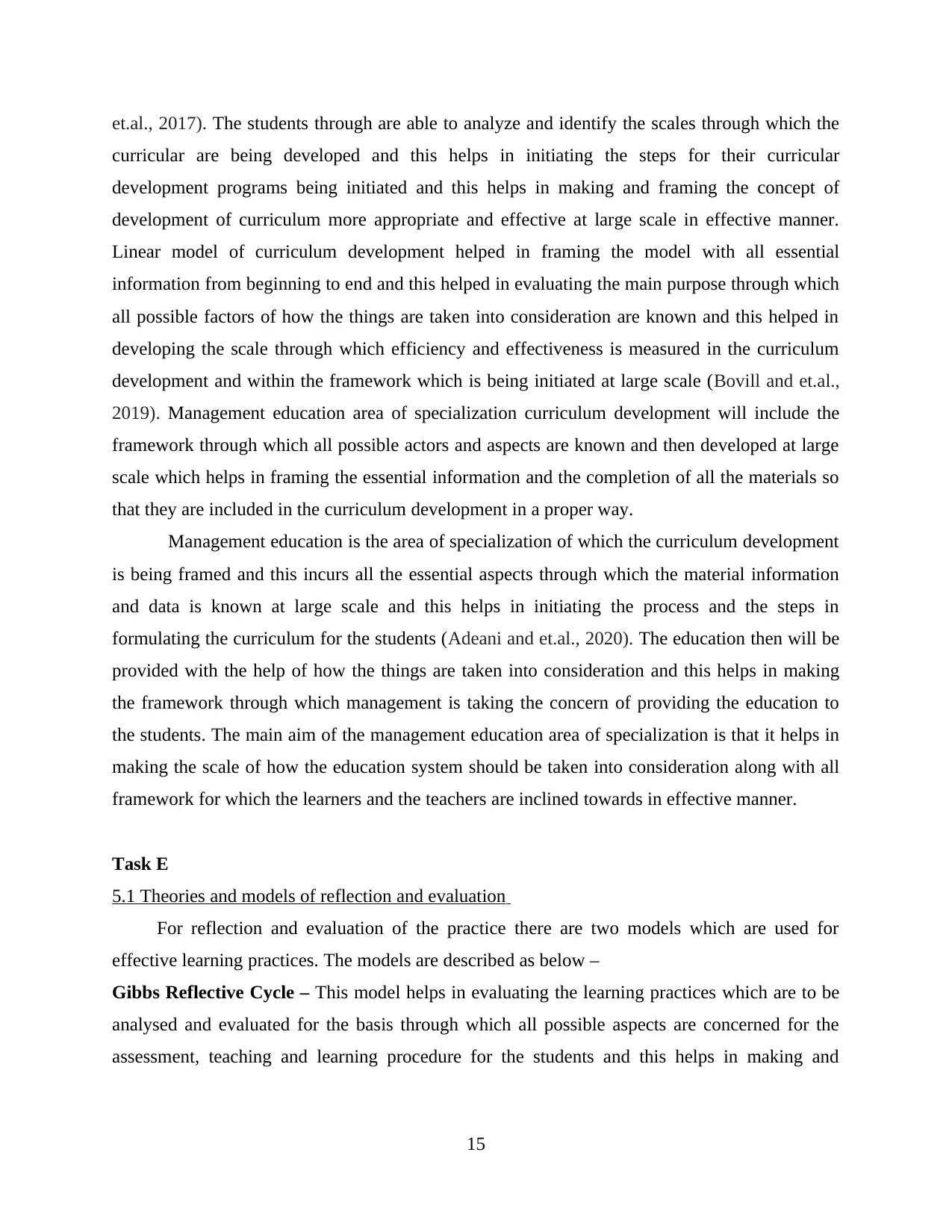
et.al., 2017). The students through are able to analyze and identify the scales through which the
curricular are being developed and this helps in initiating the steps for their curricular
development programs being initiated and this helps in making and framing the concept of
development of curriculum more appropriate and effective at large scale in effective manner.
Linear model of curriculum development helped in framing the model with all essential
information from beginning to end and this helped in evaluating the main purpose through which
all possible factors of how the things are taken into consideration are known and this helped in
developing the scale through which efficiency and effectiveness is measured in the curriculum
development and within the framework which is being initiated at large scale (Bovill and et.al.,
2019). Management education area of specialization curriculum development will include the
framework through which all possible actors and aspects are known and then developed at large
scale which helps in framing the essential information and the completion of all the materials so
that they are included in the curriculum development in a proper way.
Management education is the area of specialization of which the curriculum development
is being framed and this incurs all the essential aspects through which the material information
and data is known at large scale and this helps in initiating the process and the steps in
formulating the curriculum for the students (Adeani and et.al., 2020). The education then will be
provided with the help of how the things are taken into consideration and this helps in making
the framework through which management is taking the concern of providing the education to
the students. The main aim of the management education area of specialization is that it helps in
making the scale of how the education system should be taken into consideration along with all
framework for which the learners and the teachers are inclined towards in effective manner.
Task E
5.1 Theories and models of reflection and evaluation
For reflection and evaluation of the practice there are two models which are used for
effective learning practices. The models are described as below –
Gibbs Reflective Cycle – This model helps in evaluating the learning practices which are to be
analysed and evaluated for the basis through which all possible aspects are concerned for the
assessment, teaching and learning procedure for the students and this helps in making and
15
curricular are being developed and this helps in initiating the steps for their curricular
development programs being initiated and this helps in making and framing the concept of
development of curriculum more appropriate and effective at large scale in effective manner.
Linear model of curriculum development helped in framing the model with all essential
information from beginning to end and this helped in evaluating the main purpose through which
all possible factors of how the things are taken into consideration are known and this helped in
developing the scale through which efficiency and effectiveness is measured in the curriculum
development and within the framework which is being initiated at large scale (Bovill and et.al.,
2019). Management education area of specialization curriculum development will include the
framework through which all possible actors and aspects are known and then developed at large
scale which helps in framing the essential information and the completion of all the materials so
that they are included in the curriculum development in a proper way.
Management education is the area of specialization of which the curriculum development
is being framed and this incurs all the essential aspects through which the material information
and data is known at large scale and this helps in initiating the process and the steps in
formulating the curriculum for the students (Adeani and et.al., 2020). The education then will be
provided with the help of how the things are taken into consideration and this helps in making
the framework through which management is taking the concern of providing the education to
the students. The main aim of the management education area of specialization is that it helps in
making the scale of how the education system should be taken into consideration along with all
framework for which the learners and the teachers are inclined towards in effective manner.
Task E
5.1 Theories and models of reflection and evaluation
For reflection and evaluation of the practice there are two models which are used for
effective learning practices. The models are described as below –
Gibbs Reflective Cycle – This model helps in evaluating the learning practices which are to be
analysed and evaluated for the basis through which all possible aspects are concerned for the
assessment, teaching and learning procedure for the students and this helps in making and
15
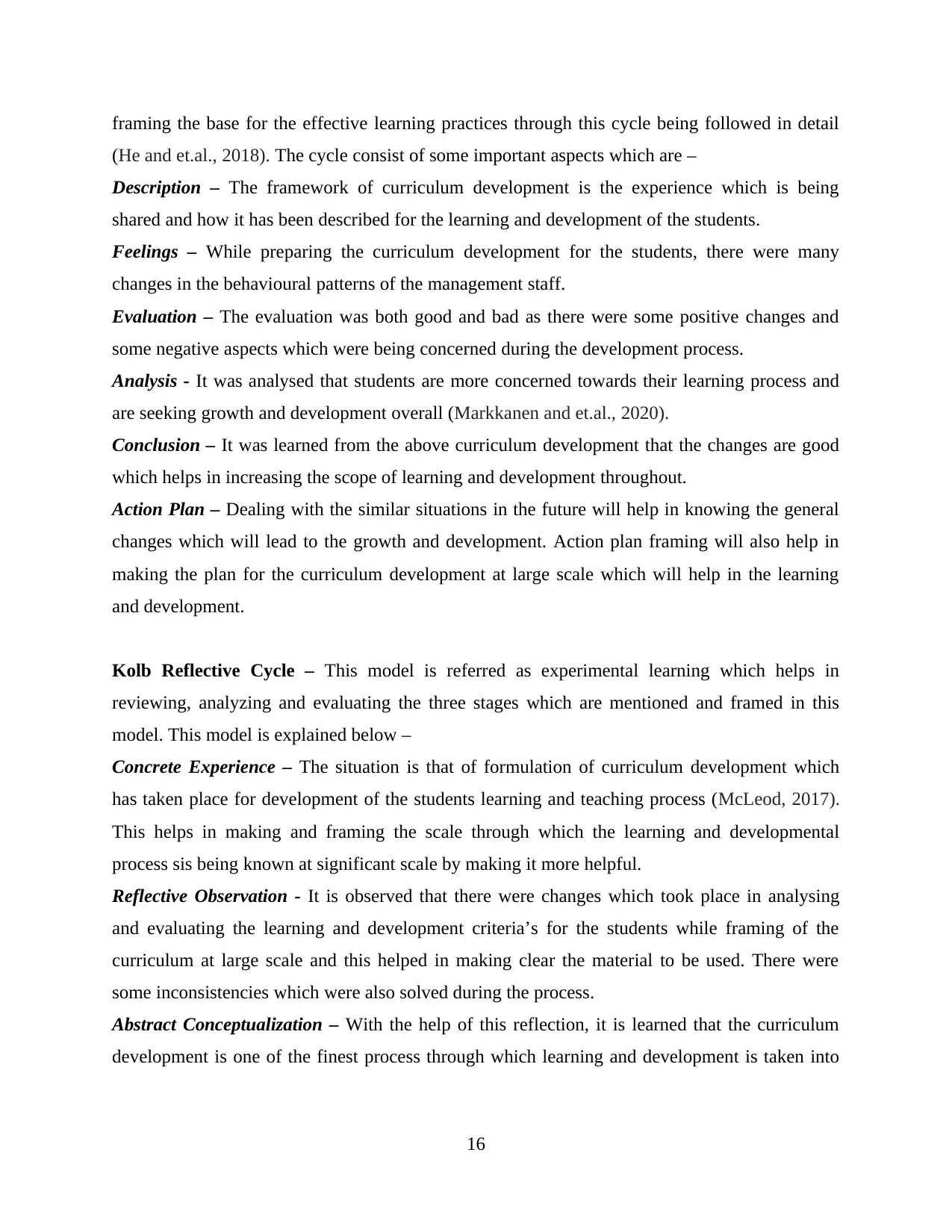
framing the base for the effective learning practices through this cycle being followed in detail
(He and et.al., 2018). The cycle consist of some important aspects which are –
Description – The framework of curriculum development is the experience which is being
shared and how it has been described for the learning and development of the students.
Feelings – While preparing the curriculum development for the students, there were many
changes in the behavioural patterns of the management staff.
Evaluation – The evaluation was both good and bad as there were some positive changes and
some negative aspects which were being concerned during the development process.
Analysis - It was analysed that students are more concerned towards their learning process and
are seeking growth and development overall (Markkanen and et.al., 2020).
Conclusion – It was learned from the above curriculum development that the changes are good
which helps in increasing the scope of learning and development throughout.
Action Plan – Dealing with the similar situations in the future will help in knowing the general
changes which will lead to the growth and development. Action plan framing will also help in
making the plan for the curriculum development at large scale which will help in the learning
and development.
Kolb Reflective Cycle – This model is referred as experimental learning which helps in
reviewing, analyzing and evaluating the three stages which are mentioned and framed in this
model. This model is explained below –
Concrete Experience – The situation is that of formulation of curriculum development which
has taken place for development of the students learning and teaching process (McLeod, 2017).
This helps in making and framing the scale through which the learning and developmental
process sis being known at significant scale by making it more helpful.
Reflective Observation - It is observed that there were changes which took place in analysing
and evaluating the learning and development criteria’s for the students while framing of the
curriculum at large scale and this helped in making clear the material to be used. There were
some inconsistencies which were also solved during the process.
Abstract Conceptualization – With the help of this reflection, it is learned that the curriculum
development is one of the finest process through which learning and development is taken into
16
(He and et.al., 2018). The cycle consist of some important aspects which are –
Description – The framework of curriculum development is the experience which is being
shared and how it has been described for the learning and development of the students.
Feelings – While preparing the curriculum development for the students, there were many
changes in the behavioural patterns of the management staff.
Evaluation – The evaluation was both good and bad as there were some positive changes and
some negative aspects which were being concerned during the development process.
Analysis - It was analysed that students are more concerned towards their learning process and
are seeking growth and development overall (Markkanen and et.al., 2020).
Conclusion – It was learned from the above curriculum development that the changes are good
which helps in increasing the scope of learning and development throughout.
Action Plan – Dealing with the similar situations in the future will help in knowing the general
changes which will lead to the growth and development. Action plan framing will also help in
making the plan for the curriculum development at large scale which will help in the learning
and development.
Kolb Reflective Cycle – This model is referred as experimental learning which helps in
reviewing, analyzing and evaluating the three stages which are mentioned and framed in this
model. This model is explained below –
Concrete Experience – The situation is that of formulation of curriculum development which
has taken place for development of the students learning and teaching process (McLeod, 2017).
This helps in making and framing the scale through which the learning and developmental
process sis being known at significant scale by making it more helpful.
Reflective Observation - It is observed that there were changes which took place in analysing
and evaluating the learning and development criteria’s for the students while framing of the
curriculum at large scale and this helped in making clear the material to be used. There were
some inconsistencies which were also solved during the process.
Abstract Conceptualization – With the help of this reflection, it is learned that the curriculum
development is one of the finest process through which learning and development is taken into
16
Secure Best Marks with AI Grader
Need help grading? Try our AI Grader for instant feedback on your assignments.
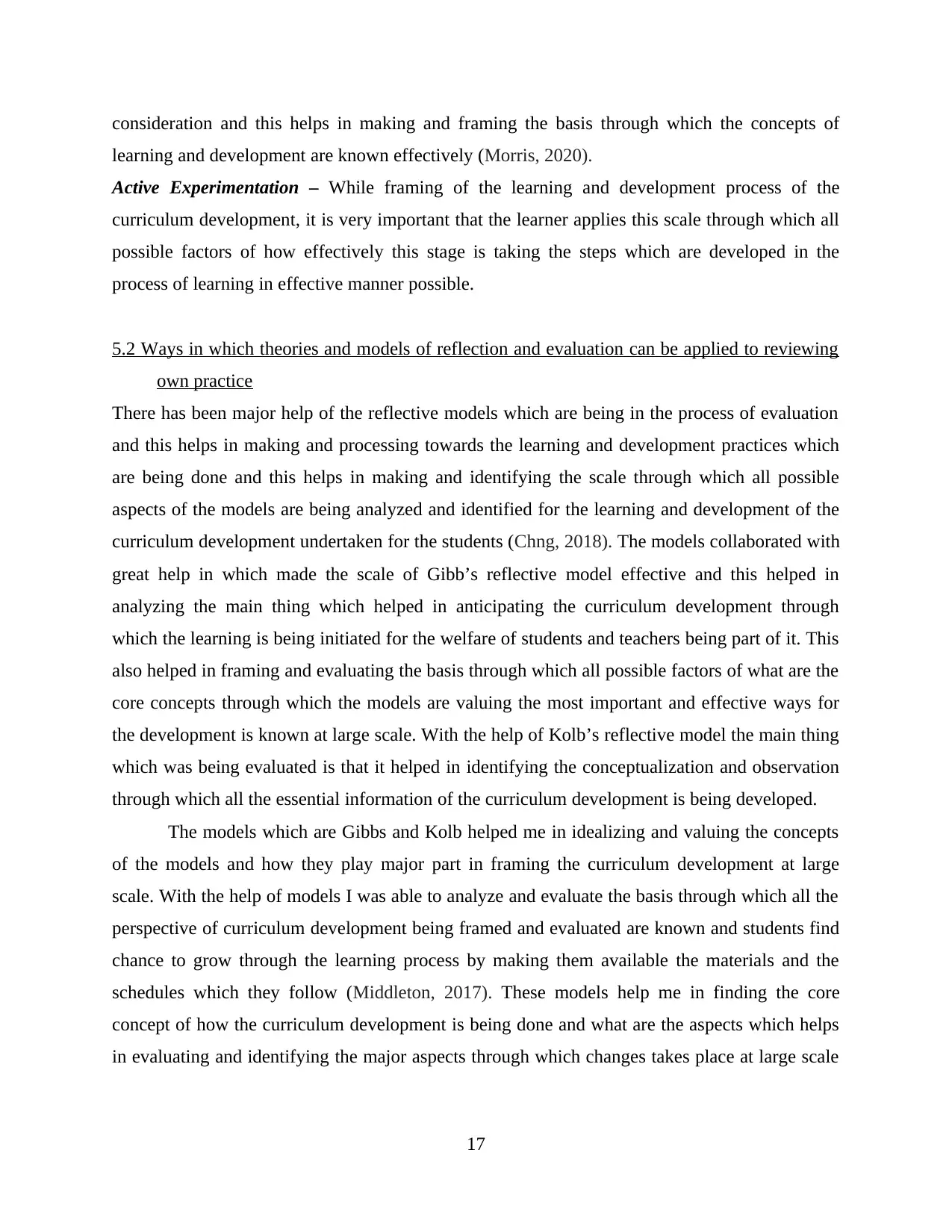
consideration and this helps in making and framing the basis through which the concepts of
learning and development are known effectively (Morris, 2020).
Active Experimentation – While framing of the learning and development process of the
curriculum development, it is very important that the learner applies this scale through which all
possible factors of how effectively this stage is taking the steps which are developed in the
process of learning in effective manner possible.
5.2 Ways in which theories and models of reflection and evaluation can be applied to reviewing
own practice
There has been major help of the reflective models which are being in the process of evaluation
and this helps in making and processing towards the learning and development practices which
are being done and this helps in making and identifying the scale through which all possible
aspects of the models are being analyzed and identified for the learning and development of the
curriculum development undertaken for the students (Chng, 2018). The models collaborated with
great help in which made the scale of Gibb’s reflective model effective and this helped in
analyzing the main thing which helped in anticipating the curriculum development through
which the learning is being initiated for the welfare of students and teachers being part of it. This
also helped in framing and evaluating the basis through which all possible factors of what are the
core concepts through which the models are valuing the most important and effective ways for
the development is known at large scale. With the help of Kolb’s reflective model the main thing
which was being evaluated is that it helped in identifying the conceptualization and observation
through which all the essential information of the curriculum development is being developed.
The models which are Gibbs and Kolb helped me in idealizing and valuing the concepts
of the models and how they play major part in framing the curriculum development at large
scale. With the help of models I was able to analyze and evaluate the basis through which all the
perspective of curriculum development being framed and evaluated are known and students find
chance to grow through the learning process by making them available the materials and the
schedules which they follow (Middleton, 2017). These models help me in finding the core
concept of how the curriculum development is being done and what are the aspects which helps
in evaluating and identifying the major aspects through which changes takes place at large scale
17
learning and development are known effectively (Morris, 2020).
Active Experimentation – While framing of the learning and development process of the
curriculum development, it is very important that the learner applies this scale through which all
possible factors of how effectively this stage is taking the steps which are developed in the
process of learning in effective manner possible.
5.2 Ways in which theories and models of reflection and evaluation can be applied to reviewing
own practice
There has been major help of the reflective models which are being in the process of evaluation
and this helps in making and processing towards the learning and development practices which
are being done and this helps in making and identifying the scale through which all possible
aspects of the models are being analyzed and identified for the learning and development of the
curriculum development undertaken for the students (Chng, 2018). The models collaborated with
great help in which made the scale of Gibb’s reflective model effective and this helped in
analyzing the main thing which helped in anticipating the curriculum development through
which the learning is being initiated for the welfare of students and teachers being part of it. This
also helped in framing and evaluating the basis through which all possible factors of what are the
core concepts through which the models are valuing the most important and effective ways for
the development is known at large scale. With the help of Kolb’s reflective model the main thing
which was being evaluated is that it helped in identifying the conceptualization and observation
through which all the essential information of the curriculum development is being developed.
The models which are Gibbs and Kolb helped me in idealizing and valuing the concepts
of the models and how they play major part in framing the curriculum development at large
scale. With the help of models I was able to analyze and evaluate the basis through which all the
perspective of curriculum development being framed and evaluated are known and students find
chance to grow through the learning process by making them available the materials and the
schedules which they follow (Middleton, 2017). These models help me in finding the core
concept of how the curriculum development is being done and what are the aspects which helps
in evaluating and identifying the major aspects through which changes takes place at large scale
17
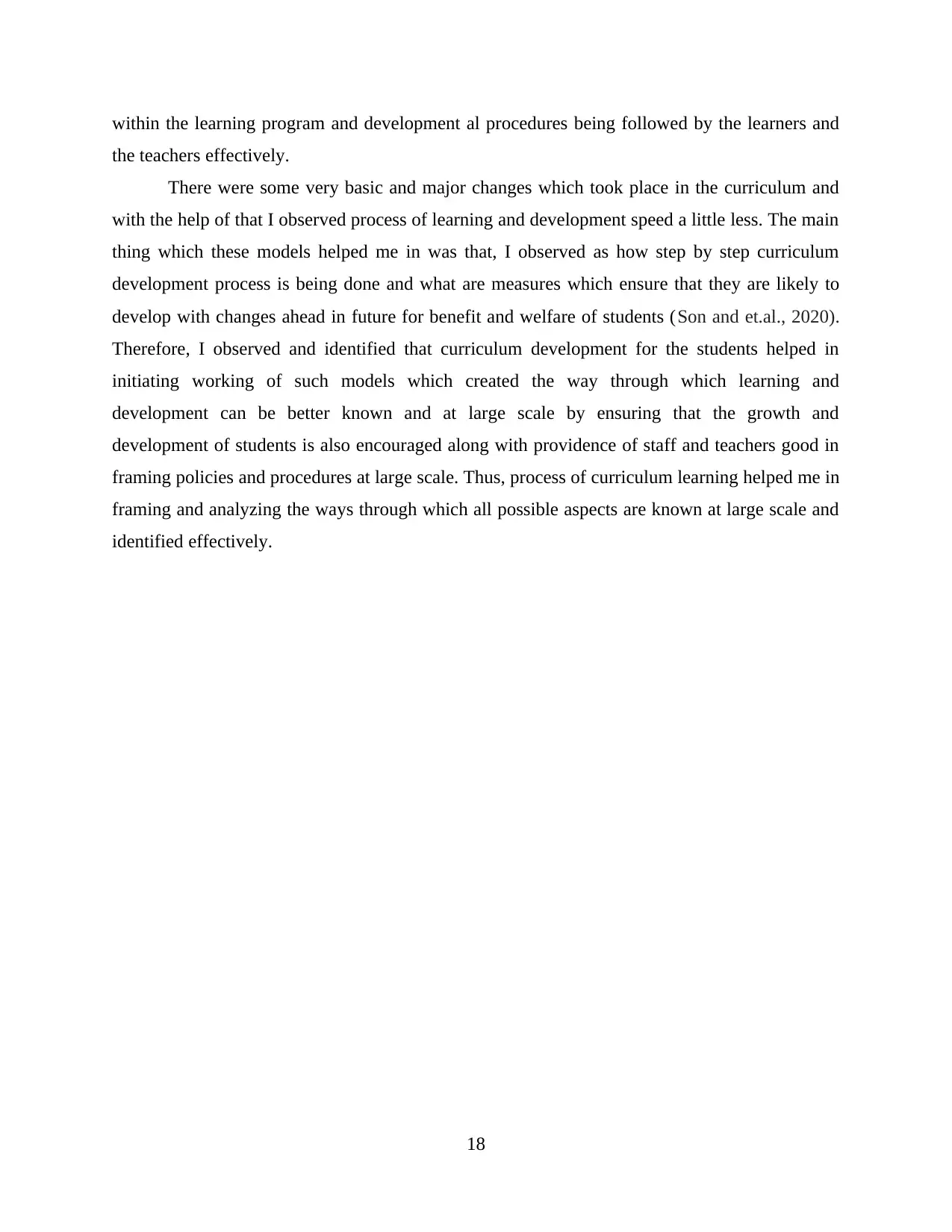
within the learning program and development al procedures being followed by the learners and
the teachers effectively.
There were some very basic and major changes which took place in the curriculum and
with the help of that I observed process of learning and development speed a little less. The main
thing which these models helped me in was that, I observed as how step by step curriculum
development process is being done and what are measures which ensure that they are likely to
develop with changes ahead in future for benefit and welfare of students (Son and et.al., 2020).
Therefore, I observed and identified that curriculum development for the students helped in
initiating working of such models which created the way through which learning and
development can be better known and at large scale by ensuring that the growth and
development of students is also encouraged along with providence of staff and teachers good in
framing policies and procedures at large scale. Thus, process of curriculum learning helped me in
framing and analyzing the ways through which all possible aspects are known at large scale and
identified effectively.
18
the teachers effectively.
There were some very basic and major changes which took place in the curriculum and
with the help of that I observed process of learning and development speed a little less. The main
thing which these models helped me in was that, I observed as how step by step curriculum
development process is being done and what are measures which ensure that they are likely to
develop with changes ahead in future for benefit and welfare of students (Son and et.al., 2020).
Therefore, I observed and identified that curriculum development for the students helped in
initiating working of such models which created the way through which learning and
development can be better known and at large scale by ensuring that the growth and
development of students is also encouraged along with providence of staff and teachers good in
framing policies and procedures at large scale. Thus, process of curriculum learning helped me in
framing and analyzing the ways through which all possible aspects are known at large scale and
identified effectively.
18
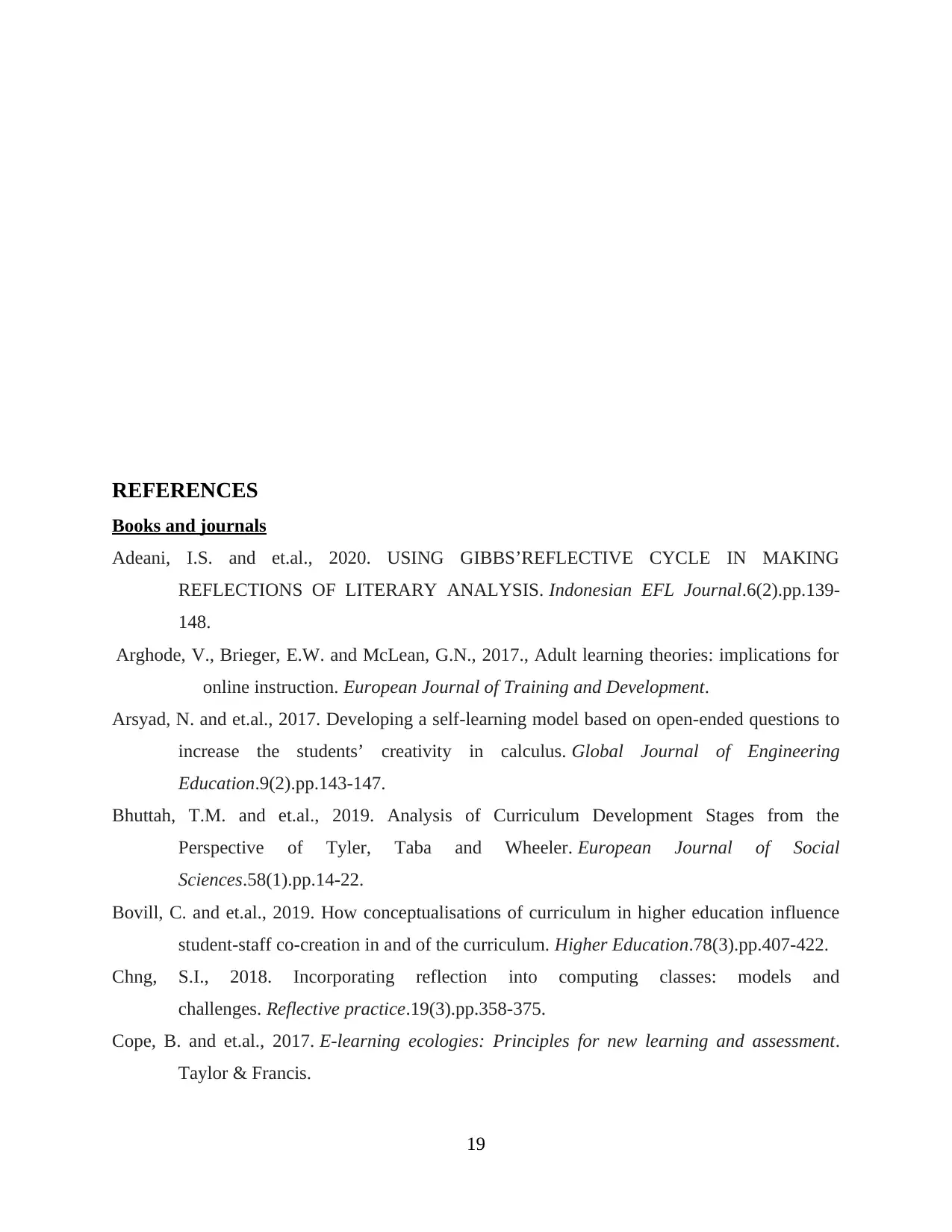
REFERENCES
Books and journals
Adeani, I.S. and et.al., 2020. USING GIBBS’REFLECTIVE CYCLE IN MAKING
REFLECTIONS OF LITERARY ANALYSIS. Indonesian EFL Journal.6(2).pp.139-
148.
Arghode, V., Brieger, E.W. and McLean, G.N., 2017., Adult learning theories: implications for
online instruction. European Journal of Training and Development.
Arsyad, N. and et.al., 2017. Developing a self-learning model based on open-ended questions to
increase the students’ creativity in calculus. Global Journal of Engineering
Education.9(2).pp.143-147.
Bhuttah, T.M. and et.al., 2019. Analysis of Curriculum Development Stages from the
Perspective of Tyler, Taba and Wheeler. European Journal of Social
Sciences.58(1).pp.14-22.
Bovill, C. and et.al., 2019. How conceptualisations of curriculum in higher education influence
student-staff co-creation in and of the curriculum. Higher Education.78(3).pp.407-422.
Chng, S.I., 2018. Incorporating reflection into computing classes: models and
challenges. Reflective practice.19(3).pp.358-375.
Cope, B. and et.al., 2017. E-learning ecologies: Principles for new learning and assessment.
Taylor & Francis.
19
Books and journals
Adeani, I.S. and et.al., 2020. USING GIBBS’REFLECTIVE CYCLE IN MAKING
REFLECTIONS OF LITERARY ANALYSIS. Indonesian EFL Journal.6(2).pp.139-
148.
Arghode, V., Brieger, E.W. and McLean, G.N., 2017., Adult learning theories: implications for
online instruction. European Journal of Training and Development.
Arsyad, N. and et.al., 2017. Developing a self-learning model based on open-ended questions to
increase the students’ creativity in calculus. Global Journal of Engineering
Education.9(2).pp.143-147.
Bhuttah, T.M. and et.al., 2019. Analysis of Curriculum Development Stages from the
Perspective of Tyler, Taba and Wheeler. European Journal of Social
Sciences.58(1).pp.14-22.
Bovill, C. and et.al., 2019. How conceptualisations of curriculum in higher education influence
student-staff co-creation in and of the curriculum. Higher Education.78(3).pp.407-422.
Chng, S.I., 2018. Incorporating reflection into computing classes: models and
challenges. Reflective practice.19(3).pp.358-375.
Cope, B. and et.al., 2017. E-learning ecologies: Principles for new learning and assessment.
Taylor & Francis.
19
Paraphrase This Document
Need a fresh take? Get an instant paraphrase of this document with our AI Paraphraser
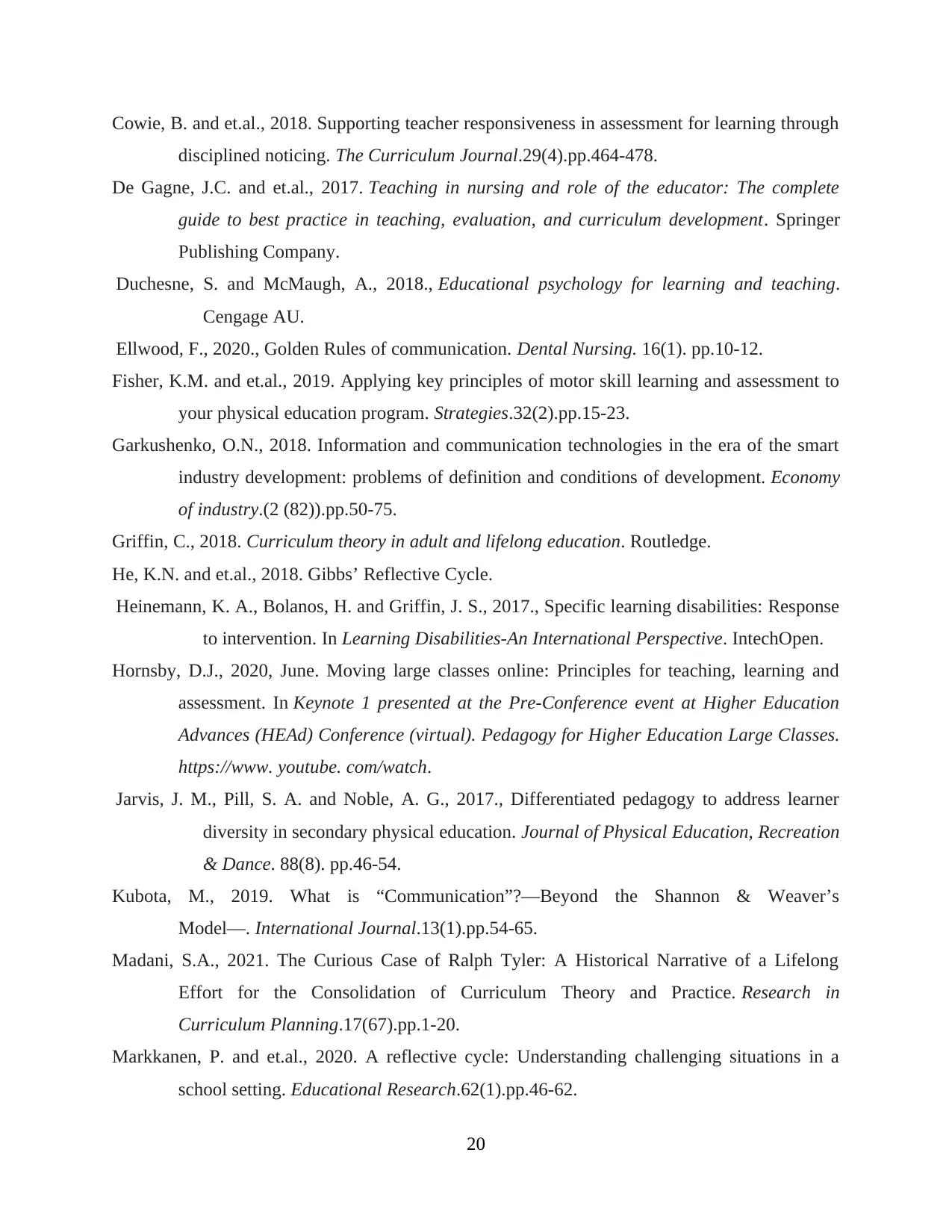
Cowie, B. and et.al., 2018. Supporting teacher responsiveness in assessment for learning through
disciplined noticing. The Curriculum Journal.29(4).pp.464-478.
De Gagne, J.C. and et.al., 2017. Teaching in nursing and role of the educator: The complete
guide to best practice in teaching, evaluation, and curriculum development. Springer
Publishing Company.
Duchesne, S. and McMaugh, A., 2018., Educational psychology for learning and teaching.
Cengage AU.
Ellwood, F., 2020., Golden Rules of communication. Dental Nursing. 16(1). pp.10-12.
Fisher, K.M. and et.al., 2019. Applying key principles of motor skill learning and assessment to
your physical education program. Strategies.32(2).pp.15-23.
Garkushenko, O.N., 2018. Information and communication technologies in the era of the smart
industry development: problems of definition and conditions of development. Economy
of industry.(2 (82)).pp.50-75.
Griffin, C., 2018. Curriculum theory in adult and lifelong education. Routledge.
He, K.N. and et.al., 2018. Gibbs’ Reflective Cycle.
Heinemann, K. A., Bolanos, H. and Griffin, J. S., 2017., Specific learning disabilities: Response
to intervention. In Learning Disabilities-An International Perspective. IntechOpen.
Hornsby, D.J., 2020, June. Moving large classes online: Principles for teaching, learning and
assessment. In Keynote 1 presented at the Pre-Conference event at Higher Education
Advances (HEAd) Conference (virtual). Pedagogy for Higher Education Large Classes.
https://www. youtube. com/watch.
Jarvis, J. M., Pill, S. A. and Noble, A. G., 2017., Differentiated pedagogy to address learner
diversity in secondary physical education. Journal of Physical Education, Recreation
& Dance. 88(8). pp.46-54.
Kubota, M., 2019. What is “Communication”?―Beyond the Shannon & Weaver’s
Model―. International Journal.13(1).pp.54-65.
Madani, S.A., 2021. The Curious Case of Ralph Tyler: A Historical Narrative of a Lifelong
Effort for the Consolidation of Curriculum Theory and Practice. Research in
Curriculum Planning.17(67).pp.1-20.
Markkanen, P. and et.al., 2020. A reflective cycle: Understanding challenging situations in a
school setting. Educational Research.62(1).pp.46-62.
20
disciplined noticing. The Curriculum Journal.29(4).pp.464-478.
De Gagne, J.C. and et.al., 2017. Teaching in nursing and role of the educator: The complete
guide to best practice in teaching, evaluation, and curriculum development. Springer
Publishing Company.
Duchesne, S. and McMaugh, A., 2018., Educational psychology for learning and teaching.
Cengage AU.
Ellwood, F., 2020., Golden Rules of communication. Dental Nursing. 16(1). pp.10-12.
Fisher, K.M. and et.al., 2019. Applying key principles of motor skill learning and assessment to
your physical education program. Strategies.32(2).pp.15-23.
Garkushenko, O.N., 2018. Information and communication technologies in the era of the smart
industry development: problems of definition and conditions of development. Economy
of industry.(2 (82)).pp.50-75.
Griffin, C., 2018. Curriculum theory in adult and lifelong education. Routledge.
He, K.N. and et.al., 2018. Gibbs’ Reflective Cycle.
Heinemann, K. A., Bolanos, H. and Griffin, J. S., 2017., Specific learning disabilities: Response
to intervention. In Learning Disabilities-An International Perspective. IntechOpen.
Hornsby, D.J., 2020, June. Moving large classes online: Principles for teaching, learning and
assessment. In Keynote 1 presented at the Pre-Conference event at Higher Education
Advances (HEAd) Conference (virtual). Pedagogy for Higher Education Large Classes.
https://www. youtube. com/watch.
Jarvis, J. M., Pill, S. A. and Noble, A. G., 2017., Differentiated pedagogy to address learner
diversity in secondary physical education. Journal of Physical Education, Recreation
& Dance. 88(8). pp.46-54.
Kubota, M., 2019. What is “Communication”?―Beyond the Shannon & Weaver’s
Model―. International Journal.13(1).pp.54-65.
Madani, S.A., 2021. The Curious Case of Ralph Tyler: A Historical Narrative of a Lifelong
Effort for the Consolidation of Curriculum Theory and Practice. Research in
Curriculum Planning.17(67).pp.1-20.
Markkanen, P. and et.al., 2020. A reflective cycle: Understanding challenging situations in a
school setting. Educational Research.62(1).pp.46-62.
20
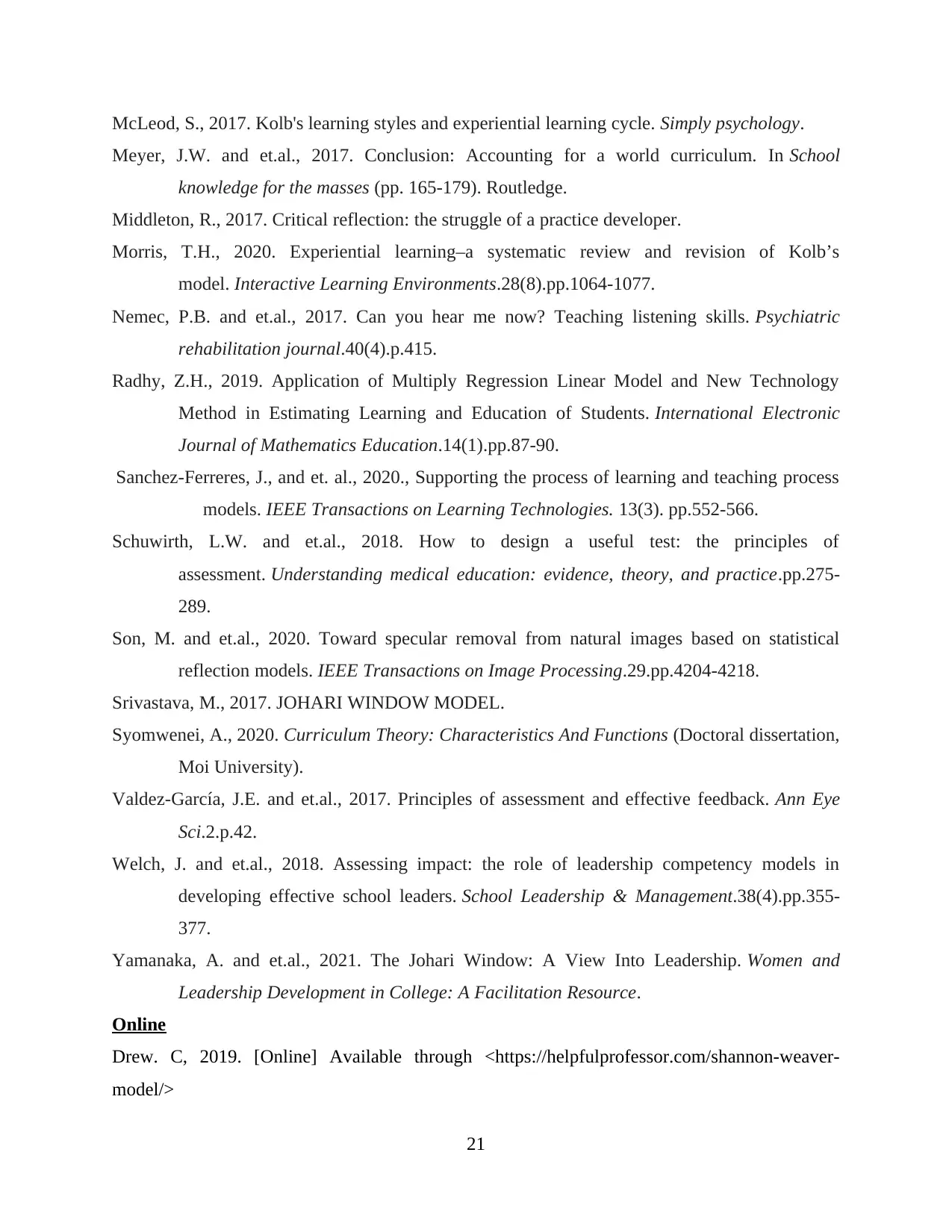
McLeod, S., 2017. Kolb's learning styles and experiential learning cycle. Simply psychology.
Meyer, J.W. and et.al., 2017. Conclusion: Accounting for a world curriculum. In School
knowledge for the masses (pp. 165-179). Routledge.
Middleton, R., 2017. Critical reflection: the struggle of a practice developer.
Morris, T.H., 2020. Experiential learning–a systematic review and revision of Kolb’s
model. Interactive Learning Environments.28(8).pp.1064-1077.
Nemec, P.B. and et.al., 2017. Can you hear me now? Teaching listening skills. Psychiatric
rehabilitation journal.40(4).p.415.
Radhy, Z.H., 2019. Application of Multiply Regression Linear Model and New Technology
Method in Estimating Learning and Education of Students. International Electronic
Journal of Mathematics Education.14(1).pp.87-90.
Sanchez-Ferreres, J., and et. al., 2020., Supporting the process of learning and teaching process
models. IEEE Transactions on Learning Technologies. 13(3). pp.552-566.
Schuwirth, L.W. and et.al., 2018. How to design a useful test: the principles of
assessment. Understanding medical education: evidence, theory, and practice.pp.275-
289.
Son, M. and et.al., 2020. Toward specular removal from natural images based on statistical
reflection models. IEEE Transactions on Image Processing.29.pp.4204-4218.
Srivastava, M., 2017. JOHARI WINDOW MODEL.
Syomwenei, A., 2020. Curriculum Theory: Characteristics And Functions (Doctoral dissertation,
Moi University).
Valdez-García, J.E. and et.al., 2017. Principles of assessment and effective feedback. Ann Eye
Sci.2.p.42.
Welch, J. and et.al., 2018. Assessing impact: the role of leadership competency models in
developing effective school leaders. School Leadership & Management.38(4).pp.355-
377.
Yamanaka, A. and et.al., 2021. The Johari Window: A View Into Leadership. Women and
Leadership Development in College: A Facilitation Resource.
Online
Drew. C, 2019. [Online] Available through <https://helpfulprofessor.com/shannon-weaver-
model/>
21
Meyer, J.W. and et.al., 2017. Conclusion: Accounting for a world curriculum. In School
knowledge for the masses (pp. 165-179). Routledge.
Middleton, R., 2017. Critical reflection: the struggle of a practice developer.
Morris, T.H., 2020. Experiential learning–a systematic review and revision of Kolb’s
model. Interactive Learning Environments.28(8).pp.1064-1077.
Nemec, P.B. and et.al., 2017. Can you hear me now? Teaching listening skills. Psychiatric
rehabilitation journal.40(4).p.415.
Radhy, Z.H., 2019. Application of Multiply Regression Linear Model and New Technology
Method in Estimating Learning and Education of Students. International Electronic
Journal of Mathematics Education.14(1).pp.87-90.
Sanchez-Ferreres, J., and et. al., 2020., Supporting the process of learning and teaching process
models. IEEE Transactions on Learning Technologies. 13(3). pp.552-566.
Schuwirth, L.W. and et.al., 2018. How to design a useful test: the principles of
assessment. Understanding medical education: evidence, theory, and practice.pp.275-
289.
Son, M. and et.al., 2020. Toward specular removal from natural images based on statistical
reflection models. IEEE Transactions on Image Processing.29.pp.4204-4218.
Srivastava, M., 2017. JOHARI WINDOW MODEL.
Syomwenei, A., 2020. Curriculum Theory: Characteristics And Functions (Doctoral dissertation,
Moi University).
Valdez-García, J.E. and et.al., 2017. Principles of assessment and effective feedback. Ann Eye
Sci.2.p.42.
Welch, J. and et.al., 2018. Assessing impact: the role of leadership competency models in
developing effective school leaders. School Leadership & Management.38(4).pp.355-
377.
Yamanaka, A. and et.al., 2021. The Johari Window: A View Into Leadership. Women and
Leadership Development in College: A Facilitation Resource.
Online
Drew. C, 2019. [Online] Available through <https://helpfulprofessor.com/shannon-weaver-
model/>
21

22
1 out of 22
Related Documents
Your All-in-One AI-Powered Toolkit for Academic Success.
+13062052269
info@desklib.com
Available 24*7 on WhatsApp / Email
![[object Object]](/_next/static/media/star-bottom.7253800d.svg)
Unlock your academic potential
© 2024 | Zucol Services PVT LTD | All rights reserved.


